Best small towns to live in across America

Andrew F. Kazmierski // Shutterstock
Best small towns to live in across America
Friendly neighbors, safe streets, excellent schools, and quieter regions near bustling cities are all qualities some of the best small towns in America share in common. To find the best small towns to live in across America, Stacker referenced Niche’s Best Places to Live study, released in August 2021, which ranked American towns by overall quality of life. The variables used by Niche include cost of living, health and fitness, and weather. Any town with more than 40,000 people was excluded.
The top cities on this list run the gamut from long-established villages in the suburbs of New York City to planned communities in Virginia and Texas. They feature stops on the Underground Railroad, buildings on the National Register of Historic Places, and community traditions—apple festivals, communal gardens, ice cream socials, and harvest markets—reflecting their roots as farming towns.
Some communities are near universities, with all of the intellectual offerings they bring. Los Alamos, New Mexico, for example, is known for the Los Alamos National Lab, while Princeton, New Jersey, is famed not only for Princeton University but also the Institute for Advanced Study, where Albert Einstein worked.
Looking for that perfect place to settle down? Keep scrolling to find a small town that may be your ideal destination.
You may also like: Best places to retire in the Midwest
![]()
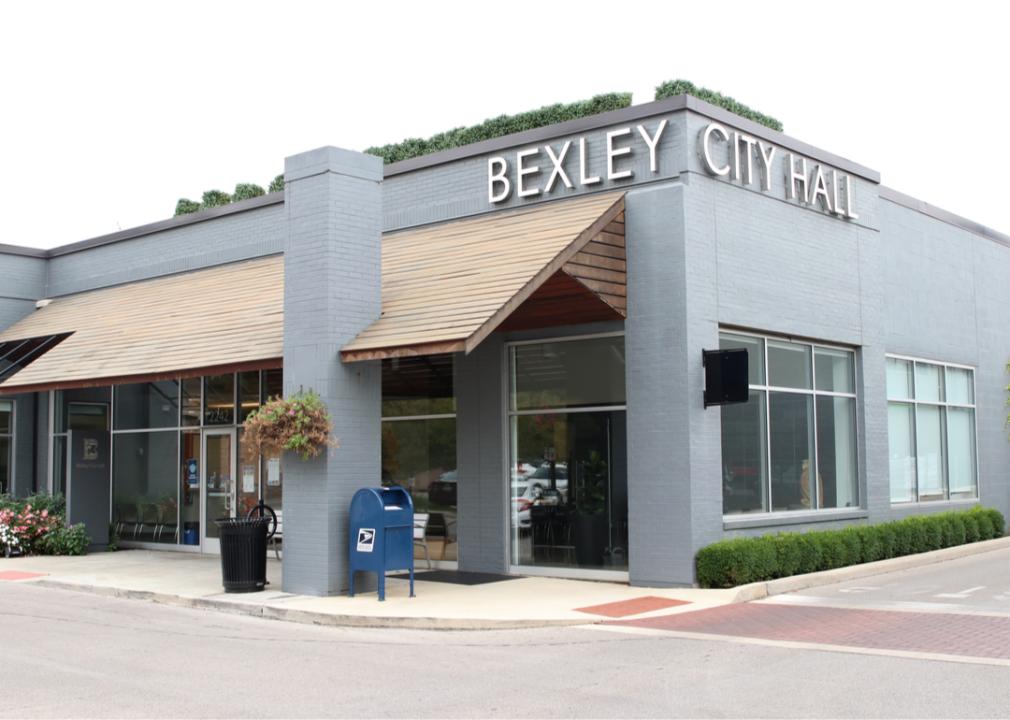
Eric Glenn // Shutterstock
#50. Bexley, Ohio
– Population: 13,786
– Homeowners: 74% of the population
– Renters: 26% of the population
– Median household income: $109,036
Bexley is a suburb of Columbus bordered by the Alum Creek, with self-described close-knit neighborhoods, a walkable Main Street, and good education. Capital University, an independent school with a Lutheran background, calls this town home. Bexley is the result of the merger of two communities: the Lutheran neighborhood of Pleasant Ridge and Bullit Park, once the site of country homes of rich residents of Columbus, including the Ohio Governor’s Residence and Heritage Garden.

quiggyt4 // Shutterstock
#49. Ridgewood, New Jersey
– Population: 25,179
– Homeowners: 78% of the population
– Renters: 22% of the population
– Median household income: $184,355
Part of the New York City metro area, the village is one of the wealthiest communities in the state. It dates to 1894, with about a dozen buildings on the National Register of Historic Places and a walkable downtown with outdoor cafes, top-rated restaurants, and local shops. Ridgewood’s high school is also in the top 30 among the state’s more than 300 schools, and students can apply for spots in competitive magnet schools.
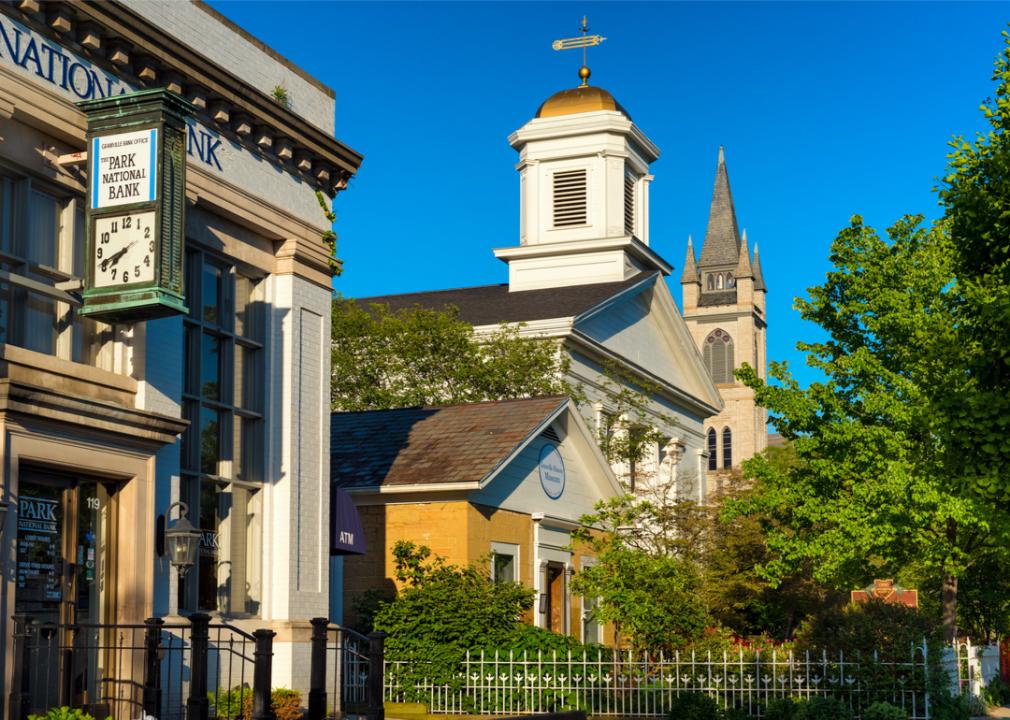
Kenneth Sponsler // Shutterstock
#48. Granville, Ohio
– Population: 5,815
– Homeowners: 79% of the population
– Renters: 21% of the population
– Median household income: $118,375
The home of Denison University and 35 miles east of the state capital, Columbus, Granville promotes itself as having “New England charm in the heart of Ohio.” It boasts a giant earthen sculpture that resembles an opossum or panther built by the area’s prehistoric people, which, today, is called “Alligator Mound.” Another attraction: on Sundays during the summer, polo is played on the grounds of the historic Bryn Du Mansion.

Peter Kniez // Shutterstock
#47. Manhasset Hills, New York
– Population: 3,615
– Homeowners: 96% of the population
– Renters: 4% of the population
– Median household income: $175,139
A hamlet in the town of Hempstead on New York’s Long Island, Manhasset Hills is a suburb of New York City. The school district serving the hamlet, the Herricks Union Free School District, is among the top 10 in the state.
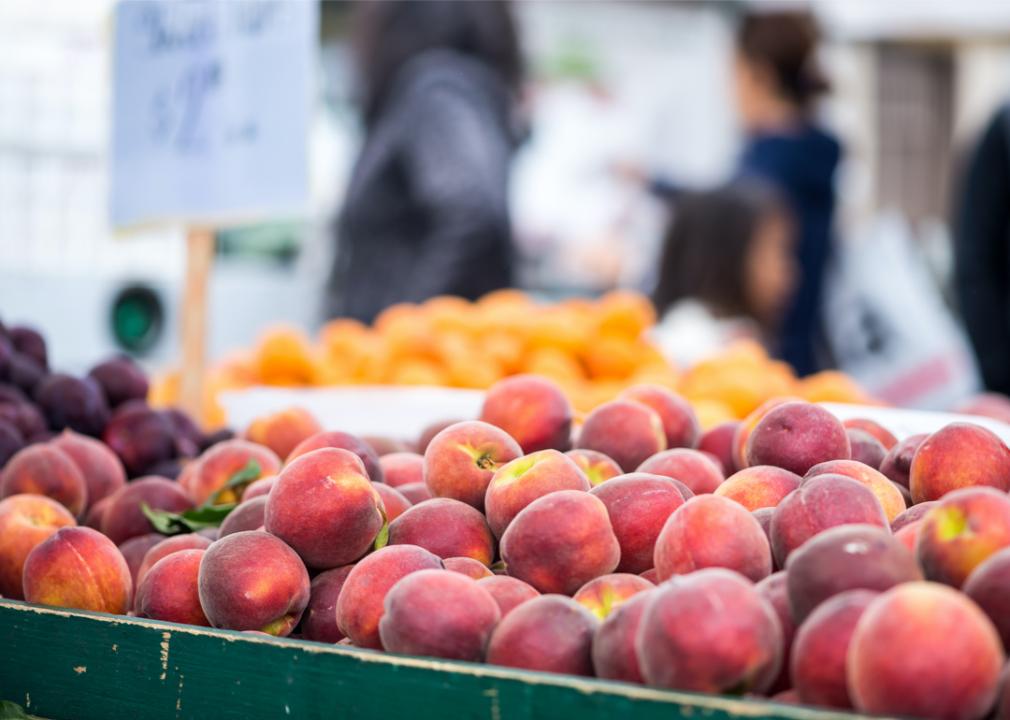
Colloidial // Shutterstock
#46. Madison, Mississippi
– Population: 25,592
– Homeowners: 93% of the population
– Renters: 7% of the population
– Median household income: $114,521
A former farming community named for former President of the United States James Madison, Madison offers such community mainstays as movies on Main Street, a men’s coffee group, an arts center, exercise classes, and the Simmons Arboretum. A summer farmers market on Main Street showcases local fruits and vegetables, baked goods, and more. The original community of Madison Station, which developed along a railroad track 10 miles from Jackson, the state capital, was destroyed during the Civil War.
You may also like: What retirement is like in 50 places around the world
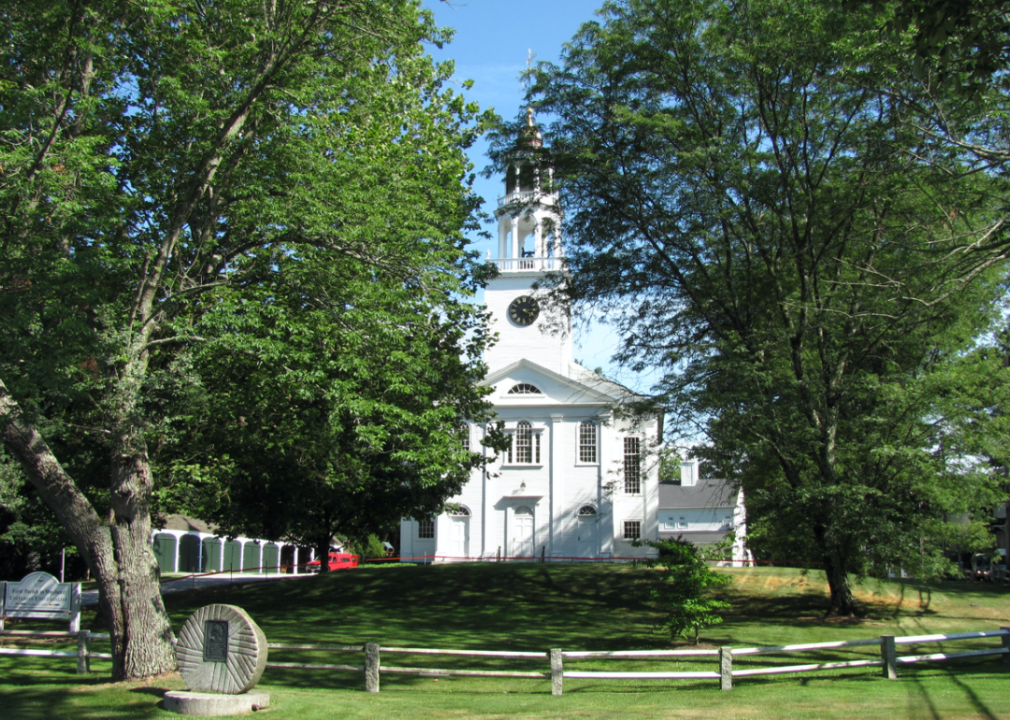
John Phelan // Wikimedia Commons
#45. Wayland, Massachusetts
– Population: 13,802
– Homeowners: 91% of the population
– Renters: 9% of the population
– Median household income: $185,375
Wayland is about halfway between Boston and Worcester, a bedroom community that remains semi-rural. Established by Puritan families in 1638, Wayland has preserved the marshes, fields, and forests around the Sudbury River. The community established the first free library in the state and has one of the best school systems in Massachusetts. Among some of its famous citizens include abolitionist Lydia Maria Child, Watergate investigator Archibald Cox, and Steven Tyler of Aerosmith.
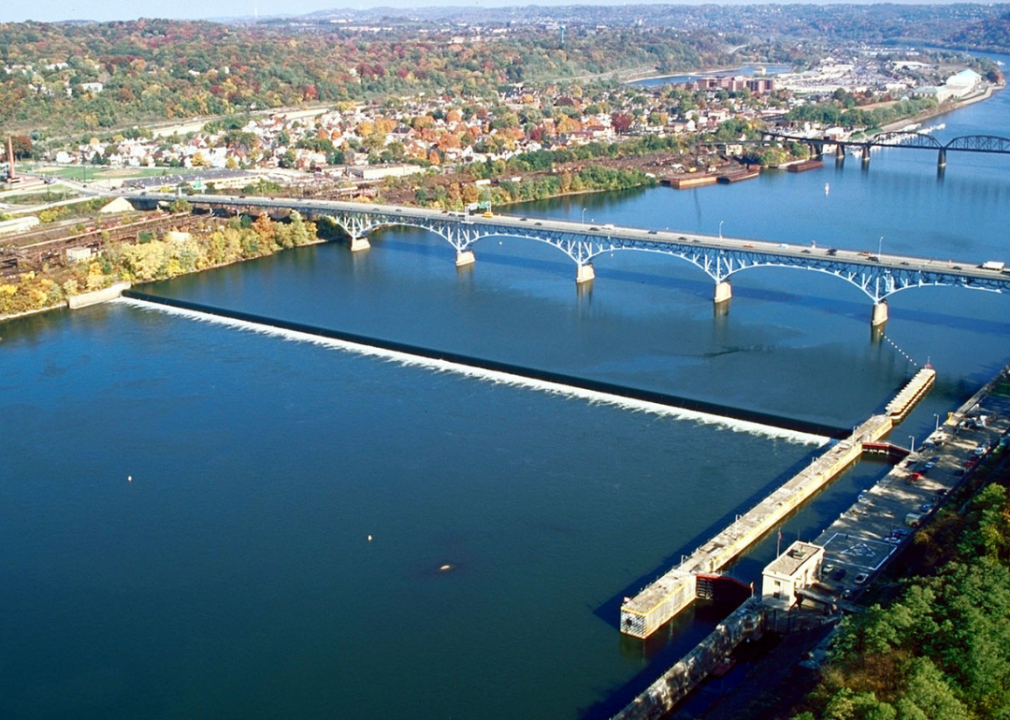
Margaret Luzier/USACE // Wikimedia Commons
#44. Aspinwall, Pennsylvania
– Population: 2,724
– Homeowners: 67% of the population
– Renters: 33% of the population
– Median household income: $84,375
A suburb of Pittsburgh, Aspinwall is a borough on the Allegheny River. It was formed as a home for mostly upper-middle-class families from Pittsburgh when, in 1890, the superintendent of the Allegheny County Workhouse bought 155 acres from Annie Aspinwall. It offers restaurants, shops, and the Allegheny RiverTrail Park, with a walking trail, a playground, native gardens, a dock, and performances by the Riverfront Theater Company. The Sauer Buildings Historic District preserves 10 buildings by German architect Frederick Sauer featuring turrets and stone walls.
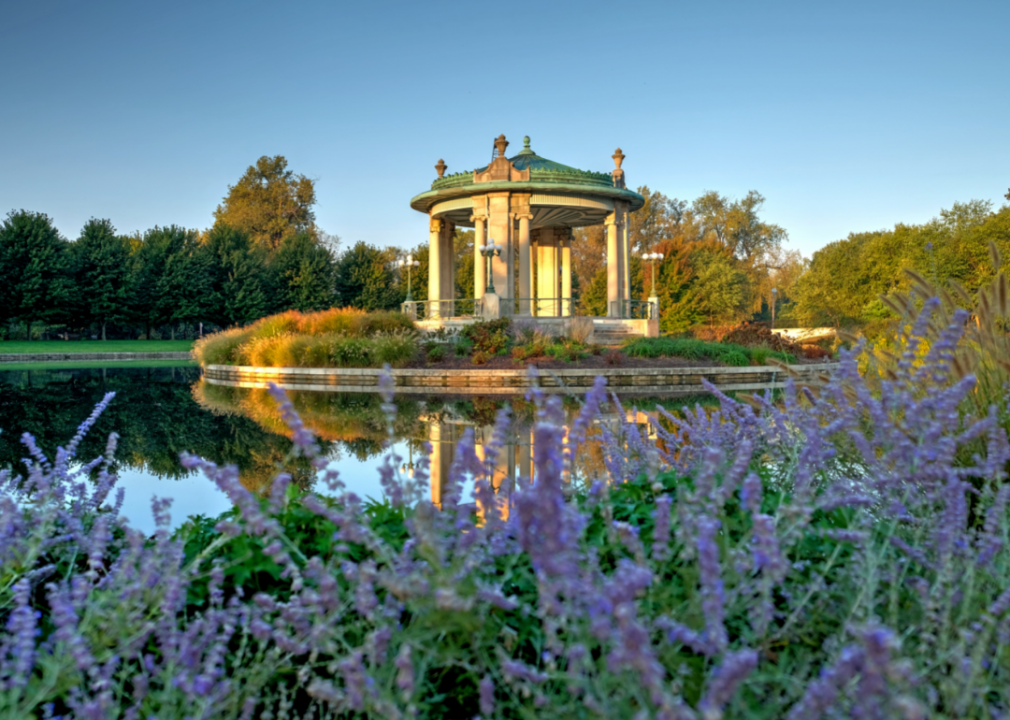
Canva
#43. Frontenac, Missouri
– Population: 3,513
– Homeowners: 96% of the population
– Renters: 4% of the population
– Median household income: $217,768
Frontenac was developed on the 128-acre Wood family farm, named after Chateau Frontenac in Quebec City. A suburb of St. Louis, it is home to the Des Peres Presbyterian Church, a stop on the Underground Railroad. Most of the community is served by the Ladue schools, among the best in the state, with U.S. News & World Report listing Ladue Horton Watkins High School as the third-best high school in the state.
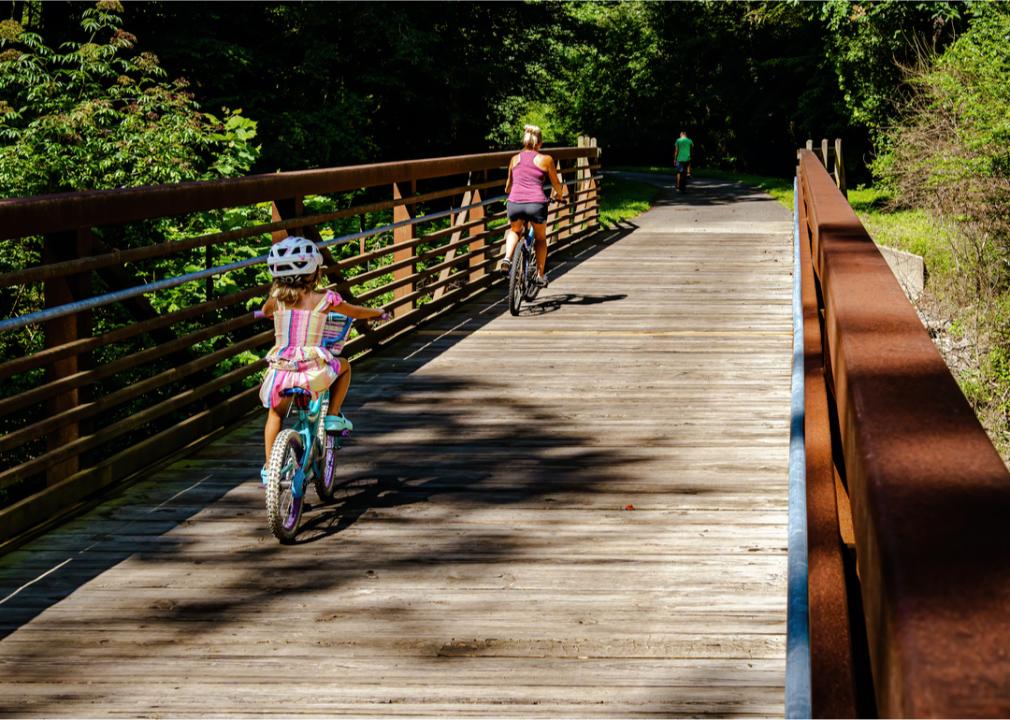
Wileydoc // Shutterstock
#42. Homewood, Alabama
– Population: 25,534
– Homeowners: 63% of the population
– Renters: 37% of the population
– Median household income: $84,157
Homewood is a suburb of Birmingham with top-rated schools. A spurt of growth in the 1870s in the area that would become Homewood was a result of Birmingham’s misfortune: a cholera epidemic that sent people out of the city. Homewood was formed through a merger of several smaller communities, beginning in the 1920s. It is home to boutiques, antique stores, and restaurants, as well as Shades Creek Greenway, for walking and bicycling, and Samford University, a private Christian college.
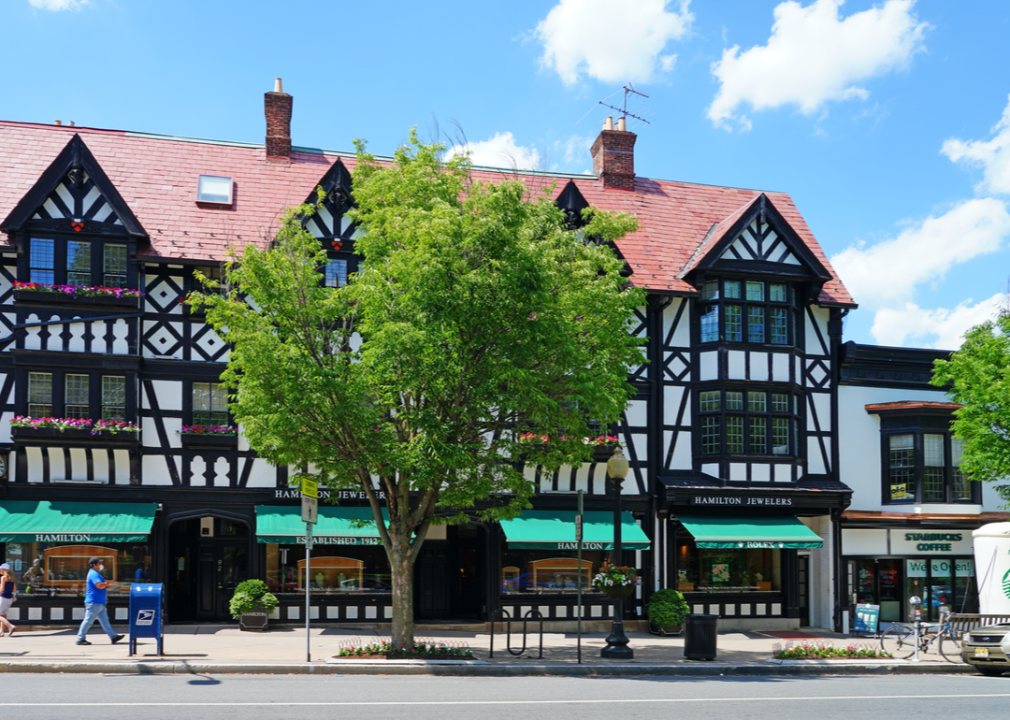
EQRoy // Shutterstock
#41. Princeton, New Jersey
– Population: 31,000
– Homeowners: 60% of the population
– Renters: 40% of the population
– Median household income: $137,672
Another university town, Princeton boasts the university of the same name as well as the world-renowned Institute for Advanced Study, where Albert Einstein was one of its first staff members. It has a range of housing, from large homes to affordable units, and many recreational opportunities including a pool complex, tennis courts, parks, playgrounds, and athletic fields. In 2013, the former Borough of Princeton and the Township of Princeton merged to become Princeton.
You may also like: Best places to raise a family in the Northeast
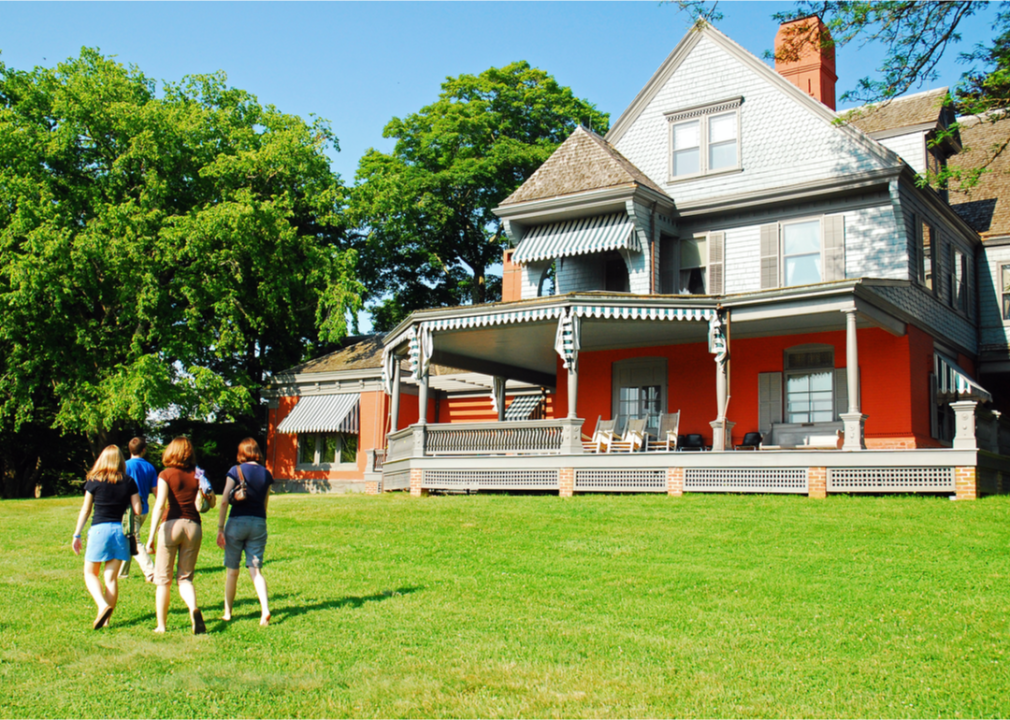
James Kirkikis // Shutterstock
#40. Syosset, New York
– Population: 19,453
– Homeowners: 91% of the population
– Renters: 9% of the population
– Median household income: $163,589
A suburb of New York City on Long Island, 5-square-mile Syosset is prized for its schools. The community is diverse, with a 22% East Asian and South Asian population, and close-knit, with a Facebook parents group and a local newspaper. Formerly farmland known for buckwheat, Syosset features mostly single-family residences but does have a gated condominium complex and some apartments.
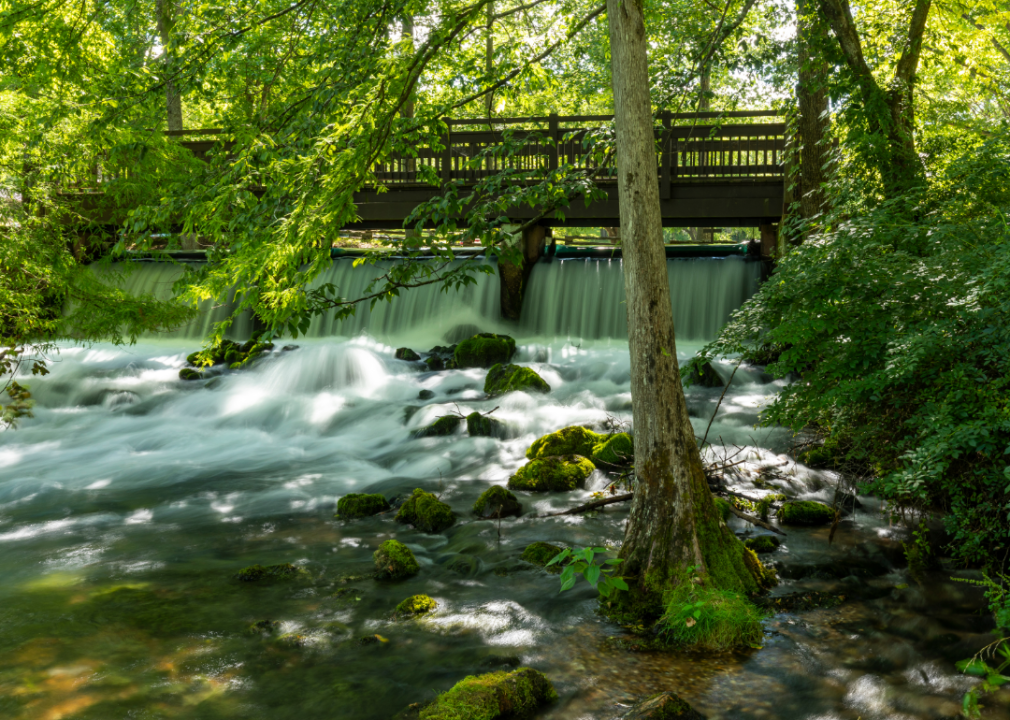
Canva
#39. Ballwin, Missouri
– Population: 30,252
– Homeowners: 83% of the population
– Renters: 17% of the population
– Median household income: $98,750
Ballwin was founded by John Ball, whose father, James, was an Irish immigrant who was awarded land after fighting in the Revolutionary War. When Missouri moved its capital to Jefferson City in 1862, the mail route from St. Louis passed by property Ball laid claim to. The “win” in the name refers to his belief that the new community would “win out” over a neighboring town. Ballwin has what is considered the best public 9-hole golf course in the St. Louis area, a community center with a gymnasium, swimming pool, and fitness center, an outdoor aquatics center, and five parks.
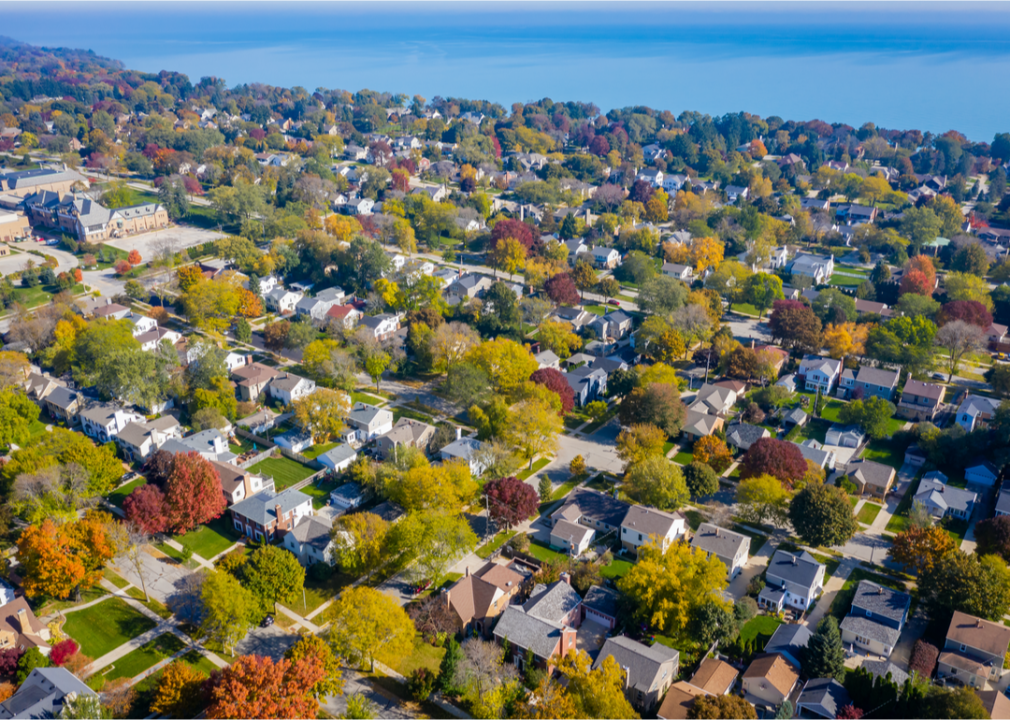
James Meyer // Shutterstock
#38. Whitefish Bay, Wisconsin
– Population: 13,972
– Homeowners: 81% of the population
– Renters: 19% of the population
– Median household income: $124,397
Whitefish Bay residents value their village for its proximity to Lake Michigan and downtown Milwaukee, its good schools, diverse housing, and strong community. It’s a village mostly of single-family houses and safe streets, and it was once the site of a resort built in 1889 by one of Milwaukee’s so-called “beer barons.” The visitors came to ride the Ferris wheel, listen to concerts, and eat whitefish from the bay.
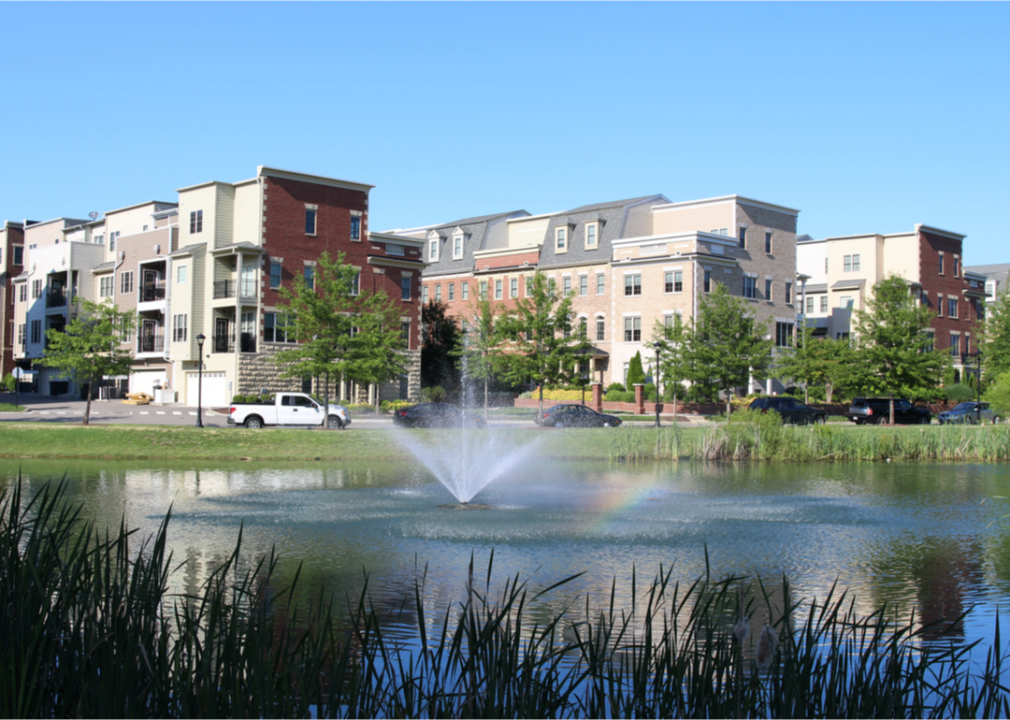
BeeRu // Shutterstock
#37. Short Pump, Virginia
– Population: 28,328
– Homeowners: 57% of the population
– Renters: 43% of the population
– Median household income: $107,321
Short Pump is a suburb of Richmond that got its name from a pump at a tavern dating from the early 1800s along what was then the main road between Richmond and Charlottesville. It’s in Henrico County and boasts Short Pump Park, which has a dog park, athletic fields, spots to picnic, and a restored 1902 two-room schoolhouse.
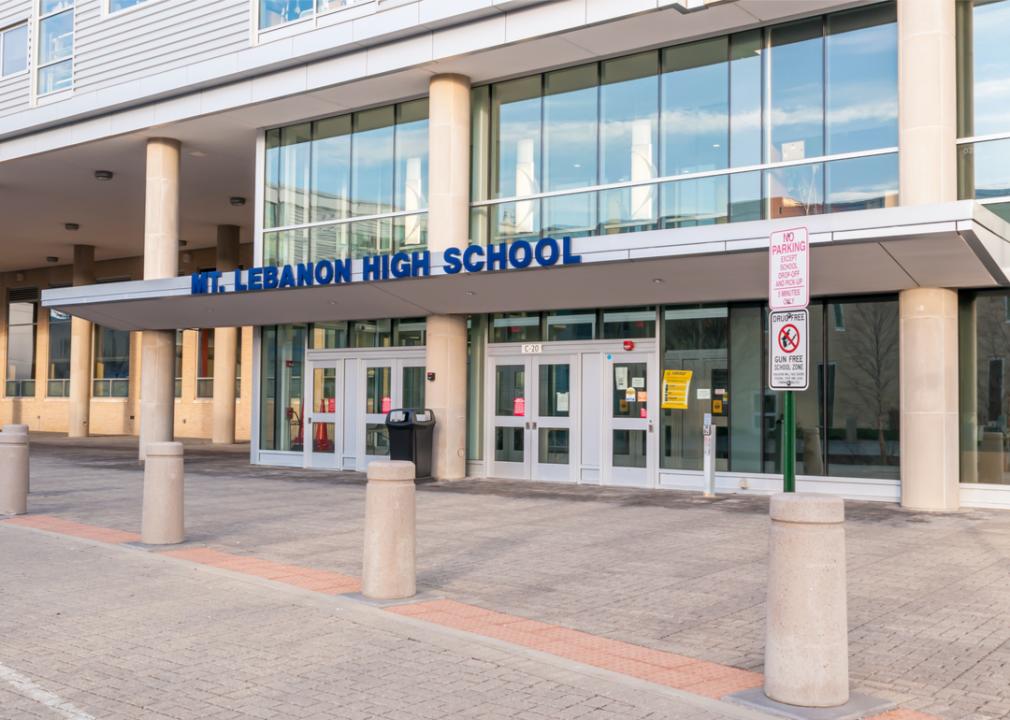
woodsnorthphoto // Shutterstock
#36. Mount Lebanon Township, Pennsylvania
– Population: 32,303
– Homeowners: 72% of the population
– Renters: 28% of the population
– Median household income: $100,011
Mount Lebanon Township became a township in 1912, on 6 square miles in western Pennsylvania. Its name is derived from the country of Lebanon, after the Rev. Joseph Clokey brought back two cedar trees from what was then the Ottoman Empire in 1850, and planted them in front of his home. It has outstanding schools and an ice skating rink, youth sports, a bocce court, tennis courts, an outdoor swimming pool, and other recreational facilities.
You may also like: Best places to raise a family in the Midwest
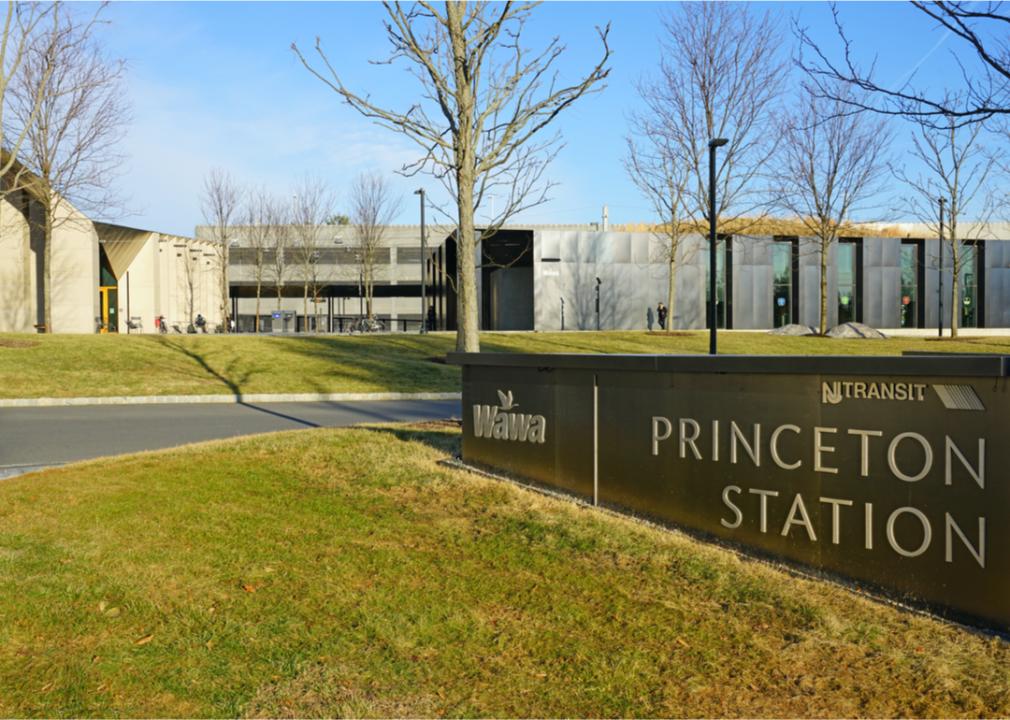
EQRoy // Shutterstock
#35. Princeton Junction, New Jersey
– Population: 2,336
– Homeowners: 82% of the population
– Renters: 18% of the population
– Median household income: $231,094
Princeton Junction grew up around what is now the Northeast Corridor Rail Line, and it originally consisted of farms, a general store, and a hotel. A one-room parsonage school was built in the mid-to-late 1800s. Part of the Trenton metro area, it is now served by the Windsor-Plainsboro Regional School District, with the West Windsor-Plainsboro High School South ranked #24 among New Jersey school districts.

Daderot // Wikimedia Commons
#34. Madeira, Ohio
– Population: 9,147
– Homeowners: 88% of the population
– Renters: 12% of the population
– Median household income: $117,944
Madeira is in the Greater Cincinnati area, incorporated in 1910 and developed along the railroad line between Cincinnati and Parkersburg, West Virginia. It promotes its strong schools, small-town feeling, and a main shopping area that can be walked to from almost anywhere in town.

SoleilC // Shutterstock
#33. Cinco Ranch, Texas
– Population: 16,437
– Homeowners: 83% of the population
– Renters: 17% of the population
– Median household income: $141,752
Cinco Ranch is a planned community in the greater Houston area with excellent schools and roots as a working ranch in the 1800s. Its transition began in 1984, and today, it has 14,000 homes, as well as parks, trails, pools, tennis courts, a golf club, and other opportunities for outdoor activities. There’s also a library, a women’s club, and swim teams.
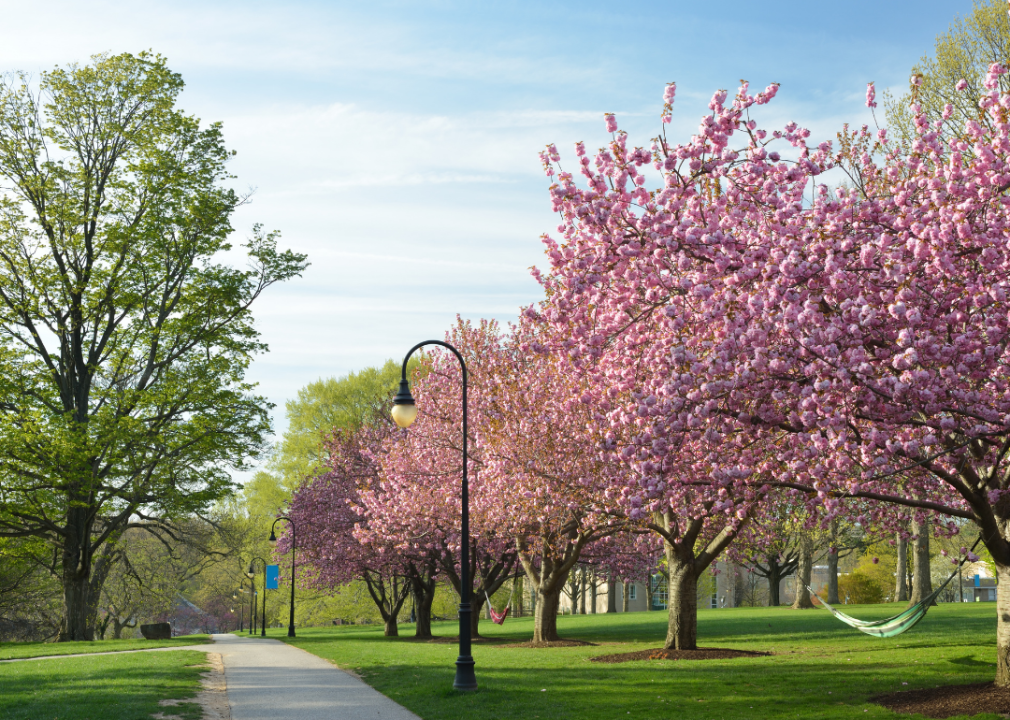
Canva
#32. Narberth, Pennsylvania
– Population: 4,345
– Homeowners: 63% of the population
– Renters: 37% of the population
– Median household income: $110,300
Narbeth is a suburb of Philadelphia along the historic Main Line of the Pennsylvania Railroad. Today, it is known for the Narbeth Dickens Festival, for which the downtown is transformed into 1840s London with puppet shows, carriage rides, and performers in period costumes. Its Fourth of July celebration began in 1942, during World War II.
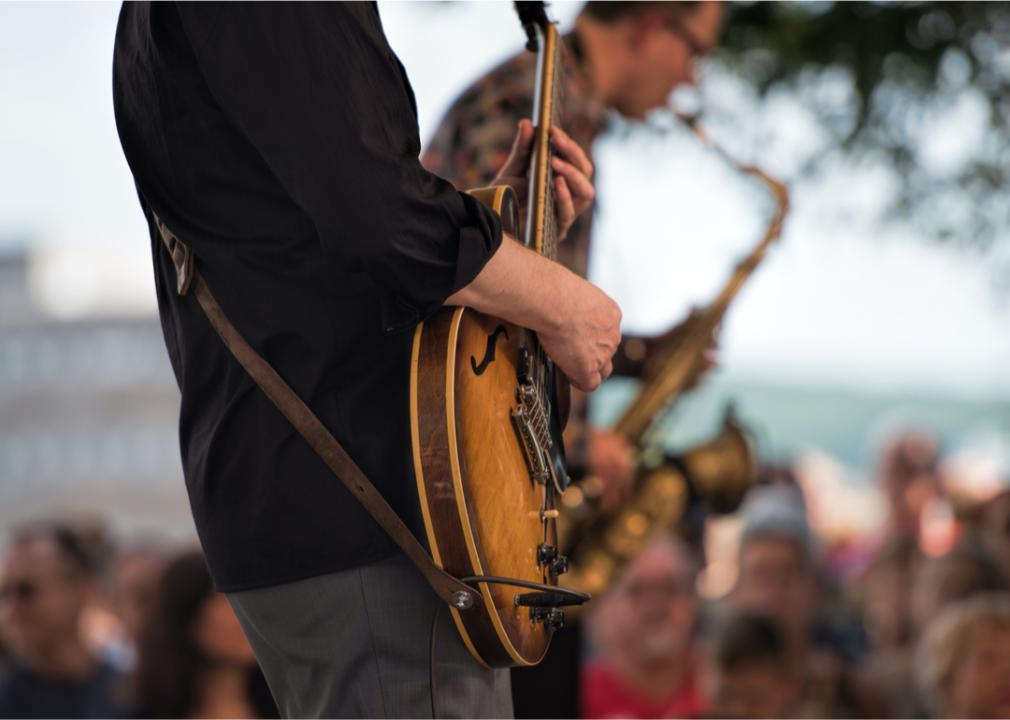
njaj // Shutterstock
#31. Innsbrook, Virginia
– Population: 8,888
– Homeowners: 57% of the population
– Renters: 43% of the population
– Median household income: $91,457
Developed in 1979, Innsbrook mixes offices, apartments, and condominiums on 800 acres connected via hiking trails and other green spaces. Part of the Richmond area, it calls itself a mixed-use community for new urbanism, with 500 companies and 20,000 employees. Nearby are single-family homes, townhouses, and other styles of homes. Among some of its yearly events include the Innsbrook Classic Golf Tournament, Innsbrook Taste of Virginia, and the midweek concert series, Innsbrook After Hours.
You may also like: Best place to live in every state
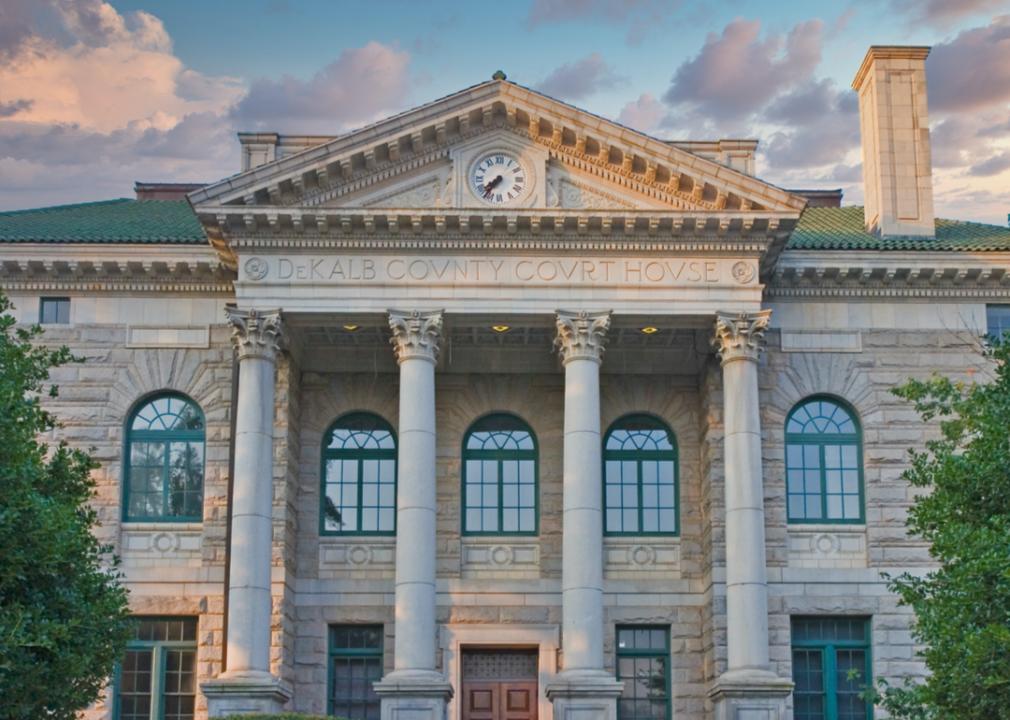
Darryl Brooks // Shutterstock
#30. Decatur, Georgia
– Population: 24,002
– Homeowners: 66% of the population
– Renters: 34% of the population
– Median household income: $106,088
The community is named after Stephen Decatur, a 19th-century U.S. naval officer. European settlers began moving into the area in the early 1820s, most of whom were farmers or tradesmen. Among its significant places include the Columbia Theological Seminary; Agnes Scott College, the first to be fully accredited in Georgia; High House, the first two-story house in Decatur, which is now on the National Register of Historic Places; and the Pythagoras Masonic Lodge, also listed on the National Register of Historic Places.
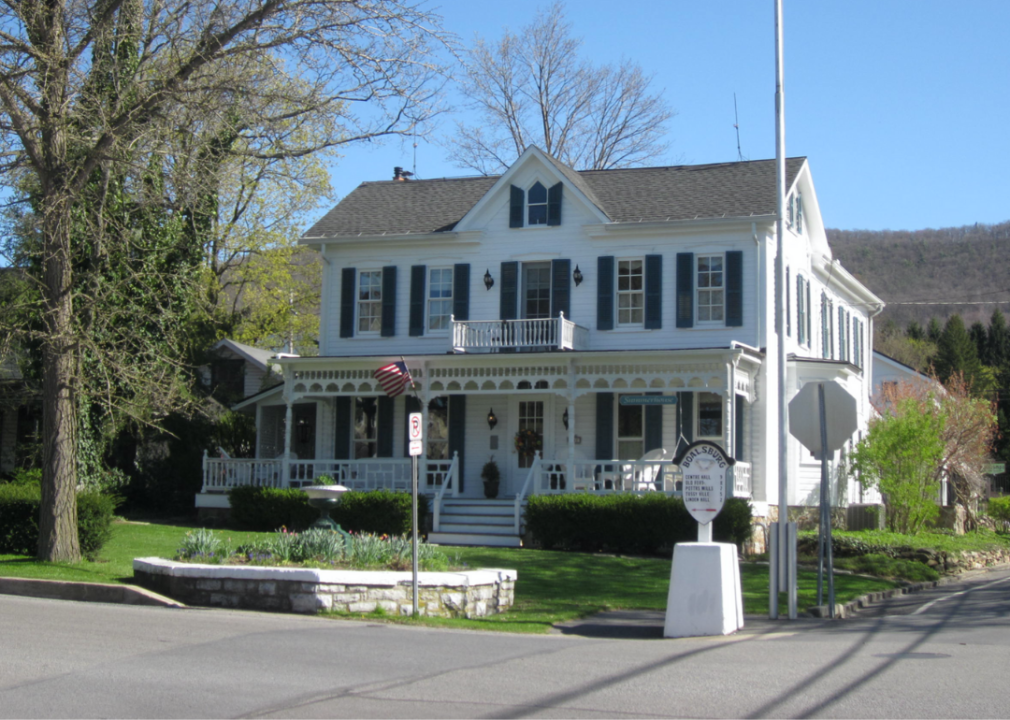
Doug Kerr // Wikimedia Commons
#29. Boalsburg, Pennsylvania
– Population: 4,642
– Homeowners: 82% of the population
– Renters: 18% of the population
– Median household income: $105,891
Close to Pennsylvania State University, Boalsburg is believed to have originated Memorial Day, and each year it hosts a traditional celebration complete with a parade, military reenactments, and a walk to the cemetery. The Columbus Chapel and Boal Mansion Museum have what are said to be two pieces of the True Cross of Jesus that the bishop of Leon in Spain gave to the Columbus family.
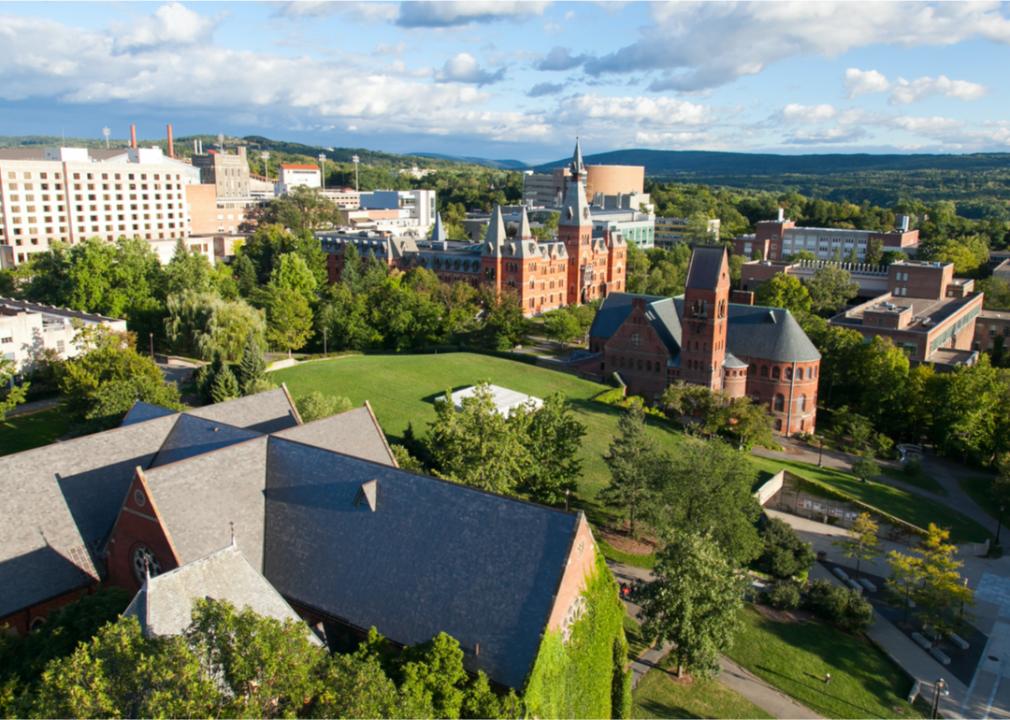
Lewis Liu // Shutterstock
#28. Cayuga Heights, New York
– Population: 3,689
– Homeowners: 52% of the population
– Renters: 48% of the population
– Median household income: $112,917
The Village of Cayuga Heights was created as a planned residential development from 1,000 acres of farmland in 1901, marketed to the faculty of nearby Cornell University and others wanting a rural neighborhood. It was incorporated 14 years later. Sunset Park, the land for which was donated by one of the village’s developers and his wife, overlooks Cayuga Lake and the City of Ithaca in the valley below and is a prized spot for watching fireworks on the Fourth of July. Silent film star Irene Castle lived in the Greystone house, which later became the headquarters for a Cornell fraternity.
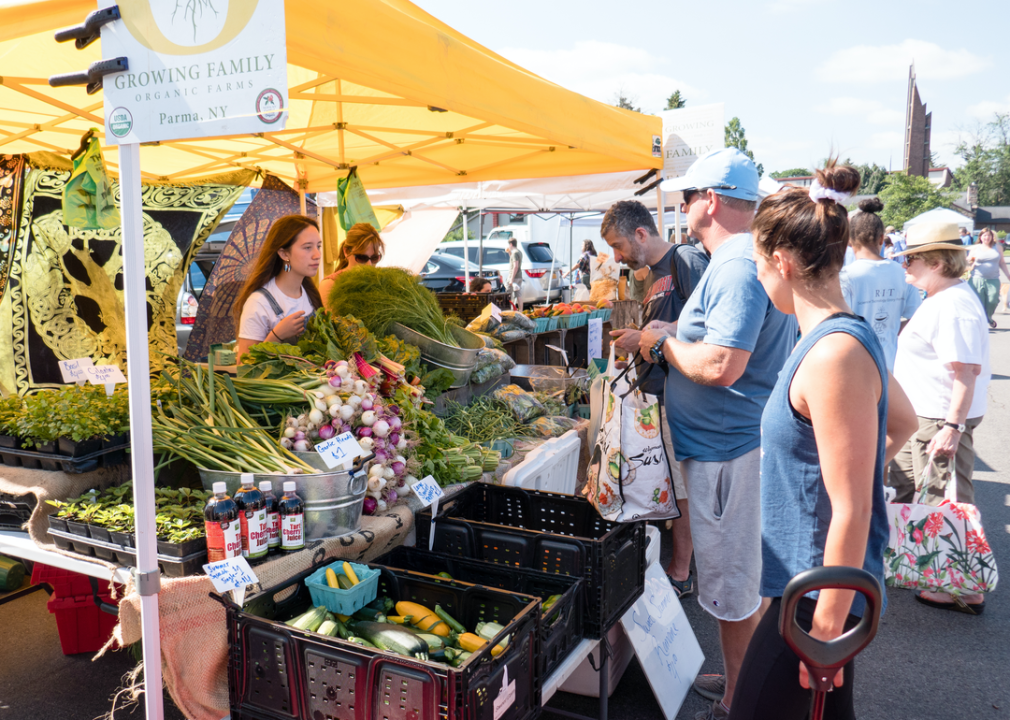
Gerald Zaffuts // Shutterstock
#27. Brighton, New York
– Population: 36,272
– Homeowners: 55% of the population
– Renters: 45% of the population
– Median household income: $75,807
A suburb of Rochester that was established in 1814, the town was originally hunting grounds for the Seneca, then farmland (at first for grains, followed by fruits and flowers) on the Erie Canal, and later a brick-making center. With the growth of Rochester and its industrial development, wealthy residents began building outside of the city, and Brighton became the top suburb in the county. Today, it is fully built up with homes and office buildings.
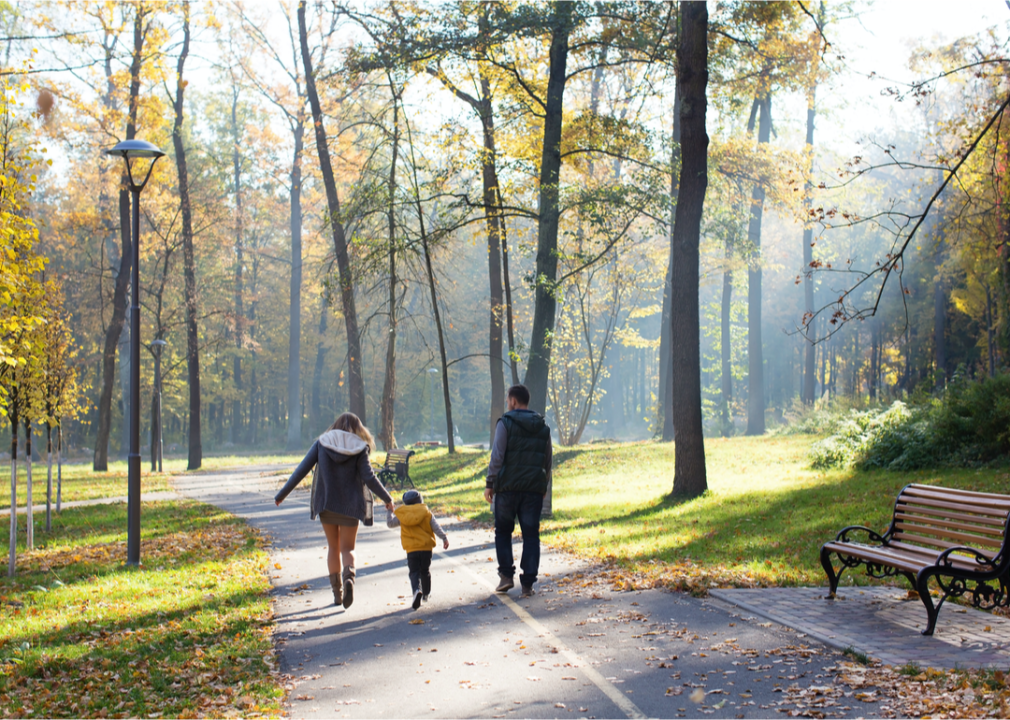
Kristina Bessolova // Shutterstock
#26. Cascades, Virginia
– Population: 11,389
– Homeowners: 77% of the population
– Renters: 23% of the population
– Median household income: $151,111
Cascades is a planned community of about 2,500 acres and 6,500 homes along the Potomac River in northern Virginia. There is also no shortage of recreational opportunities, boasting 15 tennis courts and 10 multipurpose courts, five swimming pools, five community centers, a bocce court, and a soccer field. A boat launch onto the Potomac River is available at the nearby Algonkian Regional Park. Throughout the year, there are yard sales, movie nights by the pool, fun runs, and holiday events.
You may also like: 50 best beach towns to live in
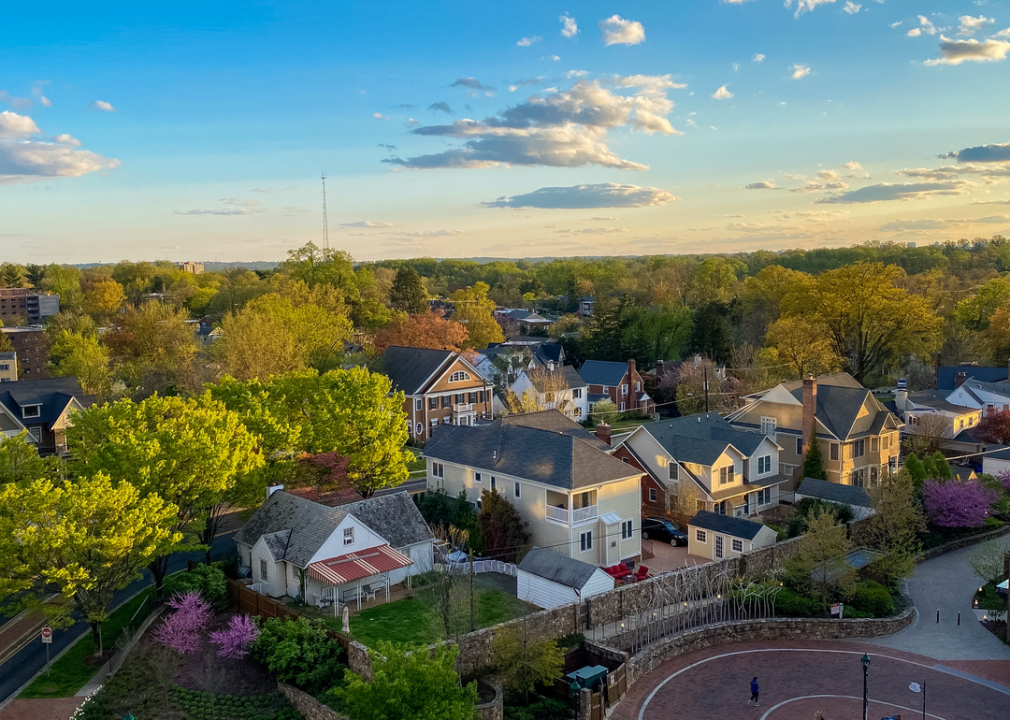
Nicole Glass Photography // Shutterstock
#25. South Kensington, Maryland
– Population: 8,763
– Homeowners: 89% of the population
– Renters: 11% of the population
– Median household income: $180,000
South Kensington is a suburb of Washington, D.C. Some sites nearby to visit include Kensington Cabin Local Park, a 4-acre park with tennis courts, softball fields, and a basketball court, and Rock Creek Regional Park, which offers archery and places to picnic.
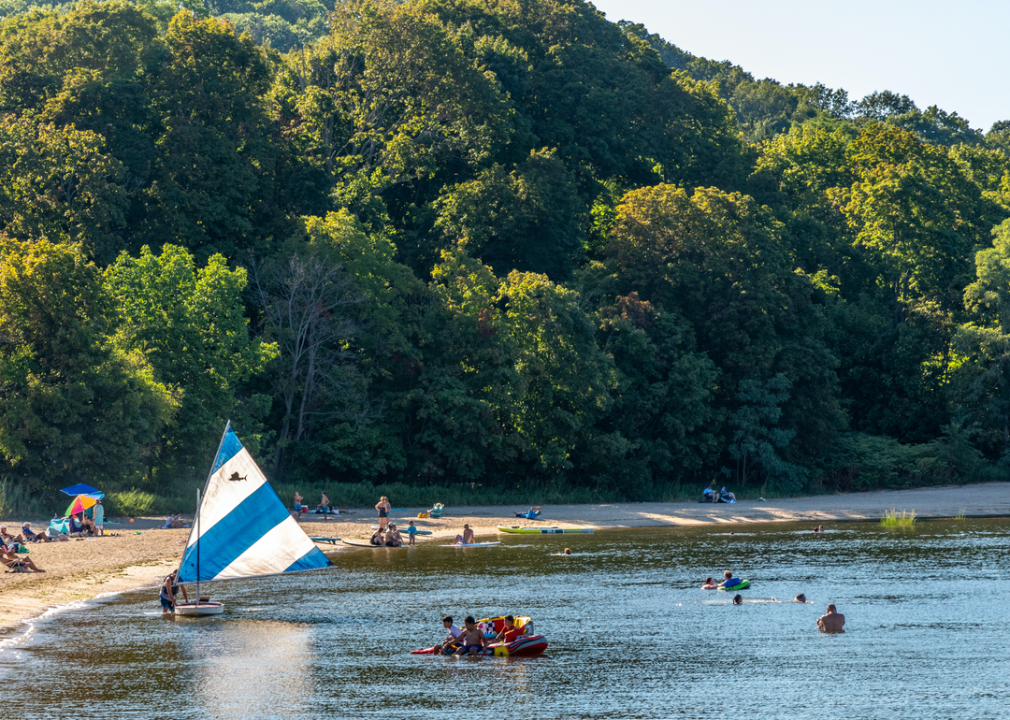
John Penney // Shutterstock
#24. Great Neck Gardens, New York
– Population: 1,150
– Homeowners: 91% of the population
– Renters: 9% of the population
– Median household income: $218,603
Great Neck Gardens is a hamlet on Long Island’s Great Neck peninsula. It includes Allenwood Park, with its softball fields, tennis courts, pond, and playgrounds. Great Neck falls within the town of North Hempstead, which has a beach, a public golf course with an 18-hole championship course, and 38 parks.
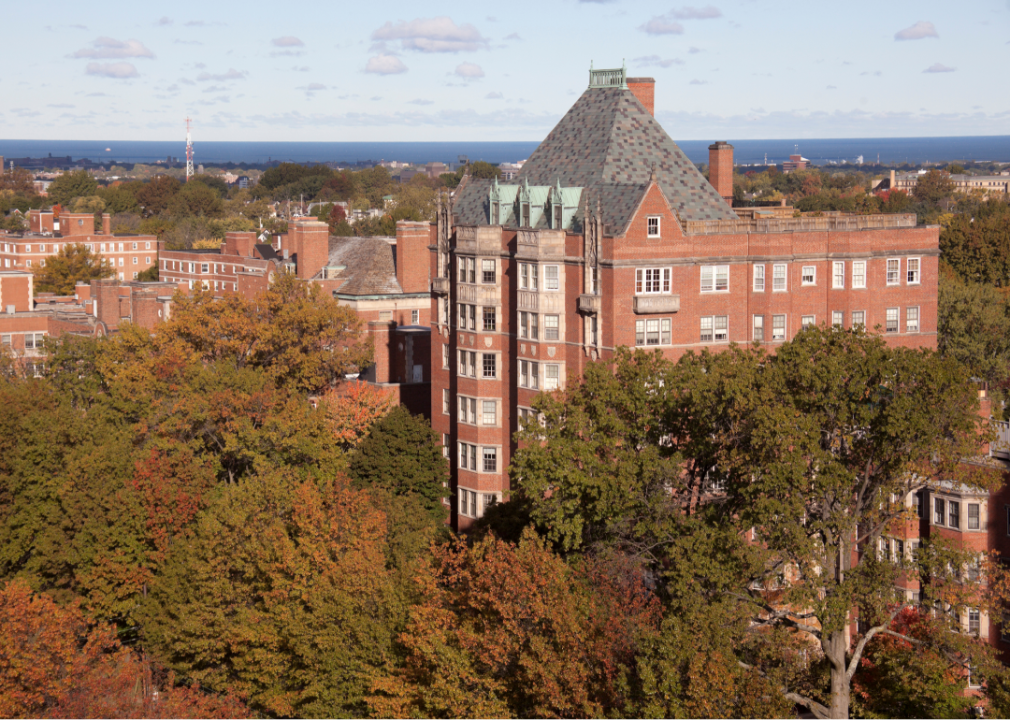
Canva
#23. Shaker Heights, Ohio
– Population: 27,387
– Homeowners: 63% of the population
– Renters: 37% of the population
– Median household income: $87,235
A suburb of Cleveland, Shaker Heights prides itself on its 200 miles of sidewalks, proximity to rapid transit stops, and recognition as a bicycle-friendly community. It boasts nationally recognized schools, nine neighborhoods of notable architecture, four lakes, a regional nature center, a 50-meter outdoor swimming pool, and a year-round ice skating rink. Its name came from the religious group, the North Union Shaker Community.
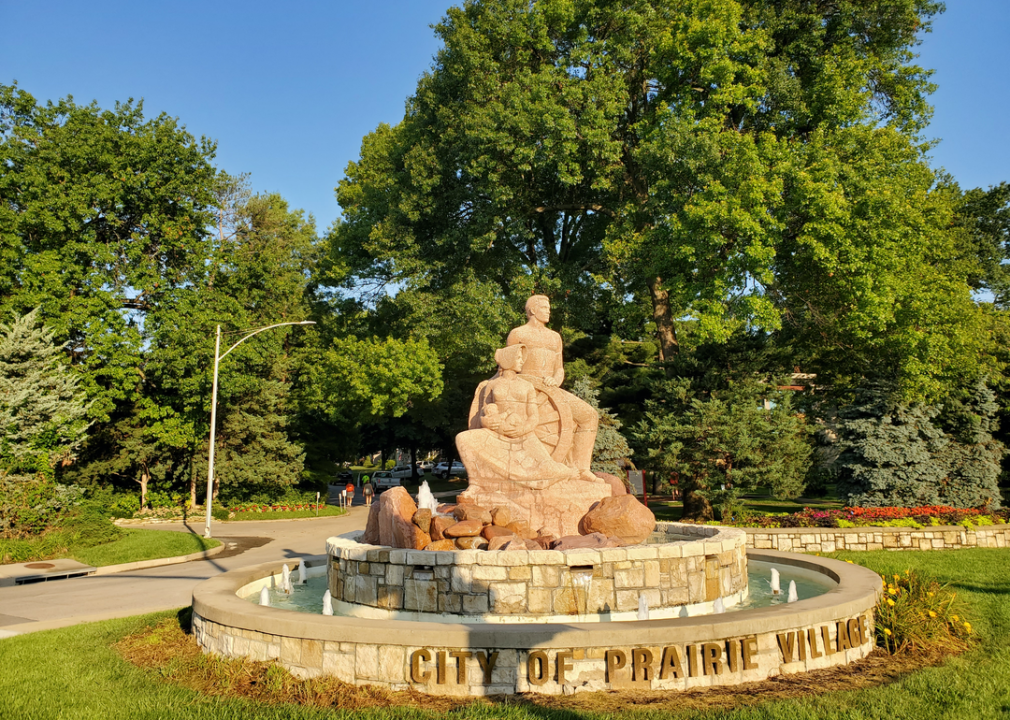
Jon Kraft // Shutterstock
#22. Prairie Village, Kansas
– Population: 22,170
– Homeowners: 77% of the population
– Renters: 23% of the population
– Median household income: $91,136
Shawnee, Osage, and Kansa once lived on the land that is now Prairie Village, part of the Kansas City, Missouri, metro area. As settlers moved west, families stopped to farm in and around the area. In the 1940s, the land was turned into housing for returning servicemen and their families. Today, there is the Village Fest, a jazz festival, art shows, a pool, and a park pavilion.
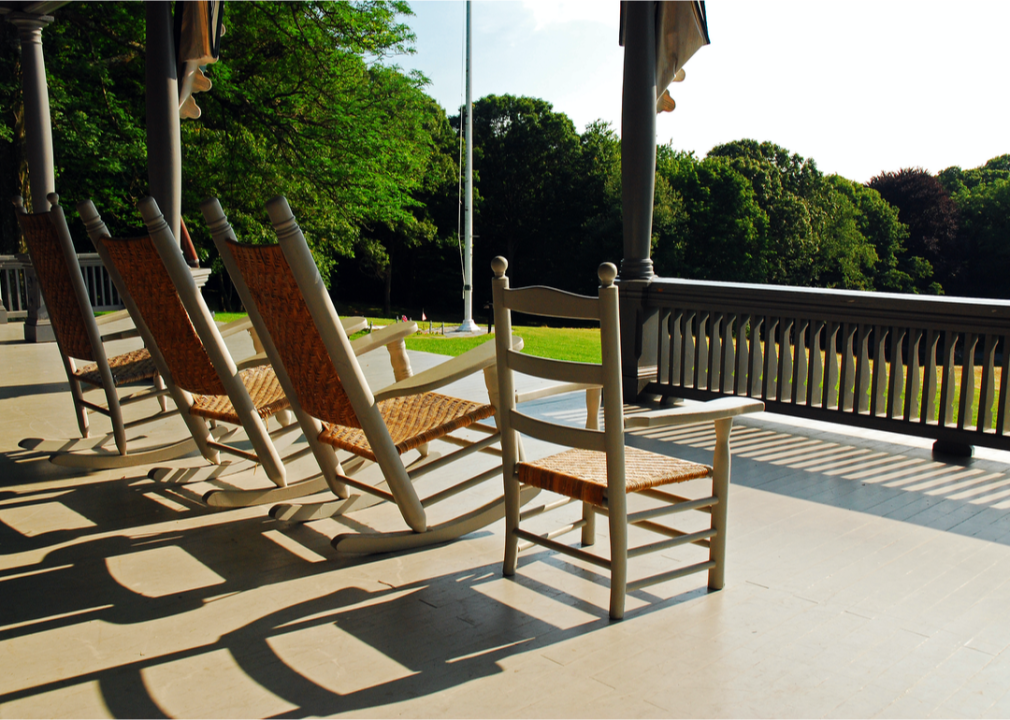
James Kirkikis // Shutterstock
#21. Jericho, New York
– Population: 13,889
– Homeowners: 87% of the population
– Renters: 13% of the population
– Median household income: $173,709
Jericho is a suburb of New York City, a hamlet on the North Shore of Long Island in the town of Oyster Bay with good schools. The English who settled here were Quakers, and a Friends meeting house was built in 1788. There was a stop on the Underground Railroad, the network that helped to move enslaved people to freedom, in one of the colonial houses that has since been designated a historic landmark. The Jericho Cider Mill, established in 1820, is still in operation.
You may also like: Best places to live in America

BAZA Production // Shutterstock
#20. Olivette, Missouri
– Population: 7,849
– Homeowners: 71% of the population
– Renters: 29% of the population
– Median household income: $86,250
Its slogan is “in the center of it all,” and for wagon trains heading west in the 1800s, Olivette was the halfway point between the Mississippi River’s Port of St. Louis and the Missouri River’s Howell’s Landing. Olivette was created in 1930 by combining four communities. Today, it has five parks or one park for every 1,500 residents, and an elevation of 700 feet above sea level, making it one of the highest communities in St. Louis County.
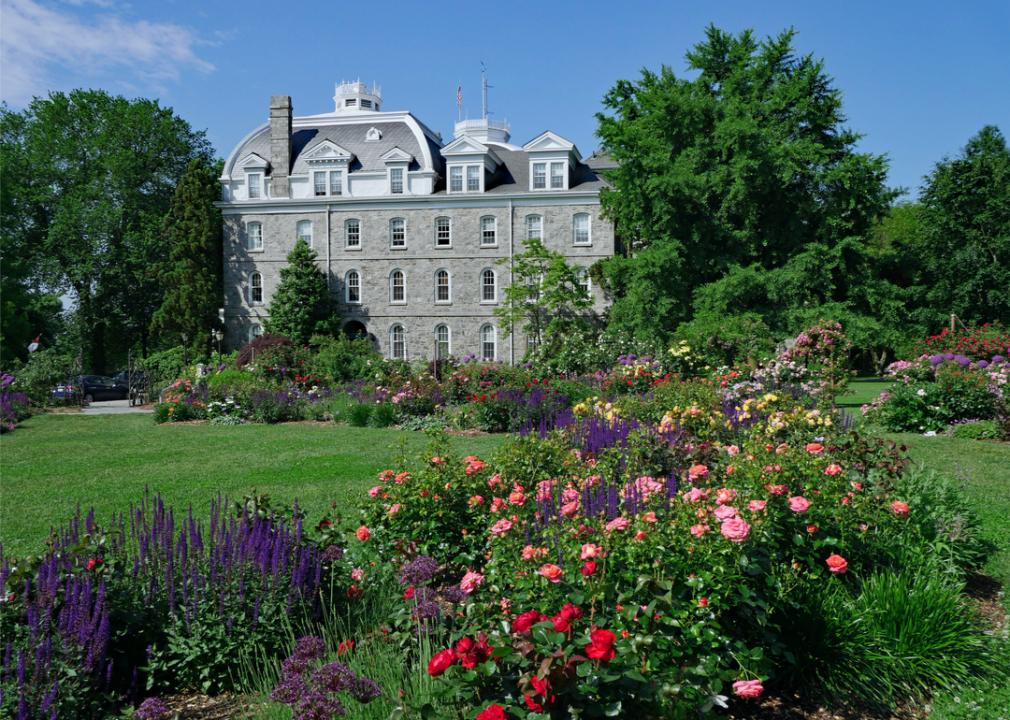
Spiroview Inc // Shutterstock
#19. Swarthmore, Pennsylvania
– Population: 6,318
– Homeowners: 77% of the population
– Renters: 23% of the population
– Median household income: $107,778
Swarthmore got its start as a college town in an area settled by Quakers to whom William Penn had granted the land. Swarthmore College was founded in 1864 when the Society of Friends decided to build a college for their children. Today, the borough is home to a top liberal arts college and is part of an excellent school district. With neighboring communities, it offers more than 20 walking trails, some created by the Swarthmore Historical Society, the Swarthmore Horticultural Society, and the college’s Scott Arboretum.

Nejdet Duzen // Shutterstock
#18. Long Grove, Illinois
– Population: 7,963
– Homeowners: 98% of the population
– Renters: 2% of the population
– Median household income: $214,073
Long Grove was Illinois’ first historic district, and it has since embraced that history by reopening a one-lane covered bridge. Its German heritage is evident in some of the annual festivals it is known for, among them an Apple Fest, a Strawberry Fest, and a Chocolate Fest, a Cocoa Crawl, a Craft Beer Festival, and a Scarecrow Day. The village is northwest of Chicago, and its schools are highly rated.
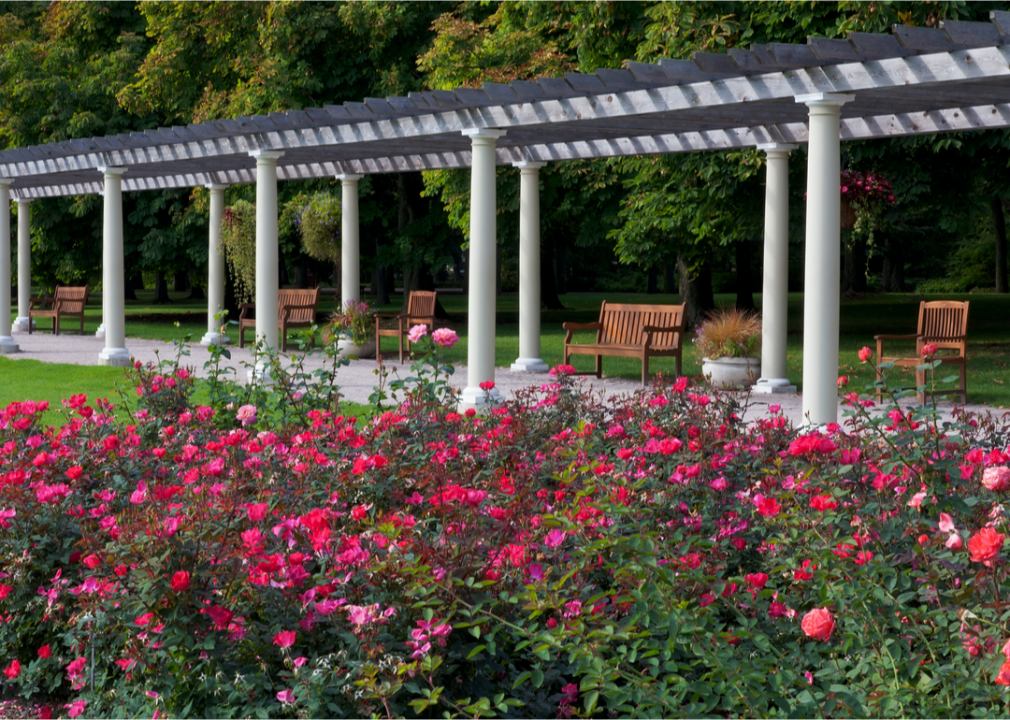
Christopher Aquino // Shutterstock
#17. Clarendon Hills, Illinois
– Population: 8,716
– Homeowners: 84% of the population
– Renters: 16% of the population
– Median household income: $111,958
The village of Clarendon Hills calls itself “the volunteer community.” It’s a suburb of Chicago with excellent schools, a summer concert series, and a weekend of carnival rides, face-painting, games, music, and other events called Daisy Days. The community grew up around the Chicago Burlington & Quincy Railroad, and the noted landscape architect Frederick Law Olmsted helped to design its curved streets.
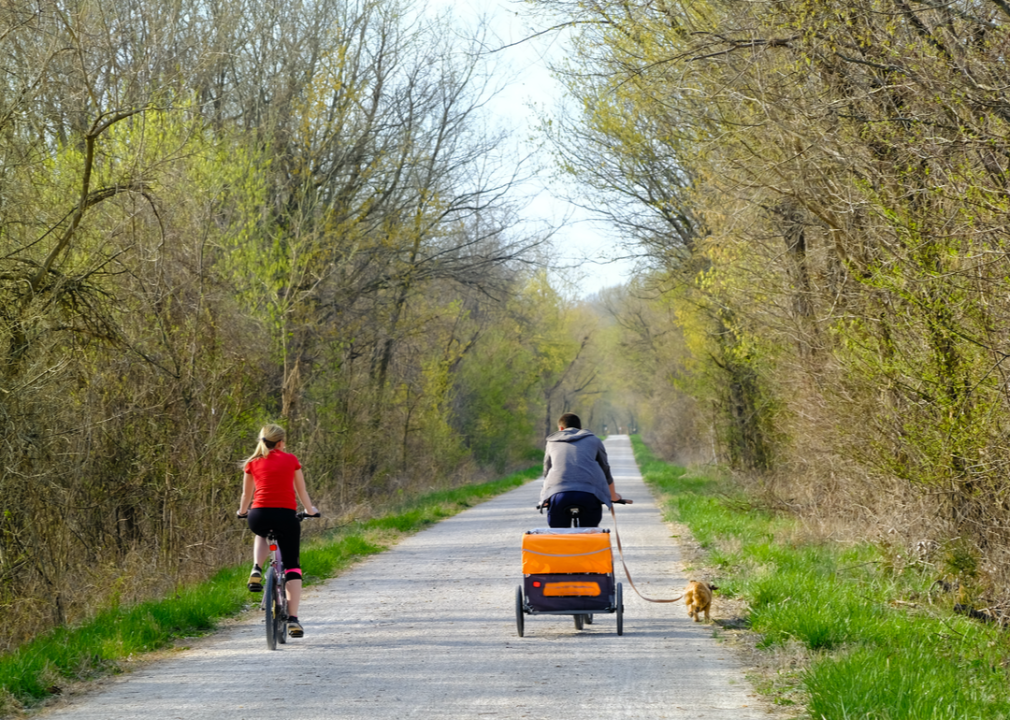
LanaG // Shutterstock
#16. Stone Ridge, Virginia
– Population: 14,220
– Homeowners: 87% of the population
– Renters: 13% of the population
– Median household income: $153,628
Stone Ridge is in Loudoun County near Dulles International Airport. It’s a planned community of condominiums, townhouses, and single-family houses. There’s a clubhouse with a fitness center, pools, tot lots, tennis courts, a basketball court, and other outdoor amenities. The schools are top-rated.
You may also like: Best places to raise a family in the West
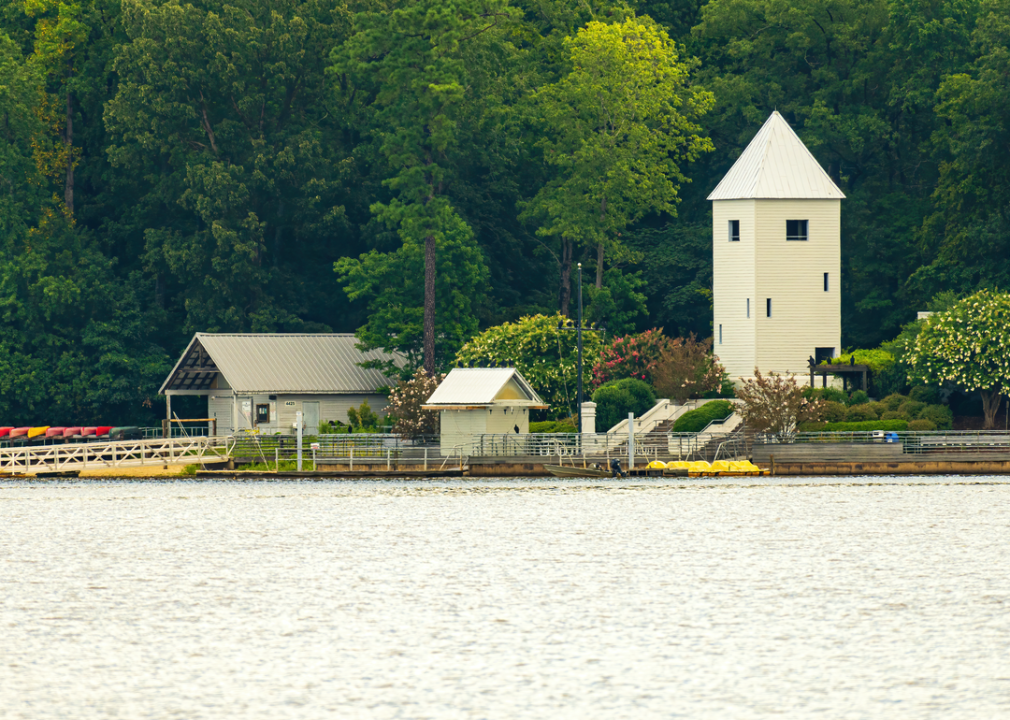
Wileydoc // Shutterstock
#15. Morrisville, North Carolina
– Population: 26,280
– Homeowners: 48% of the population
– Renters: 52% of the population
– Median household income: $101,738
Morrisville is part of the Research Triangle, and its motto is “Live connected. Live well.” It is the oldest community in Wake County and named for Jeremiah Morris, who donated land to the North Carolina Railroad, along which the town was built. On April 13, 1865, it was the site of one of the last battles of the Civil War. It has a community center, pools, and other recreational amenities, as well as good schools.
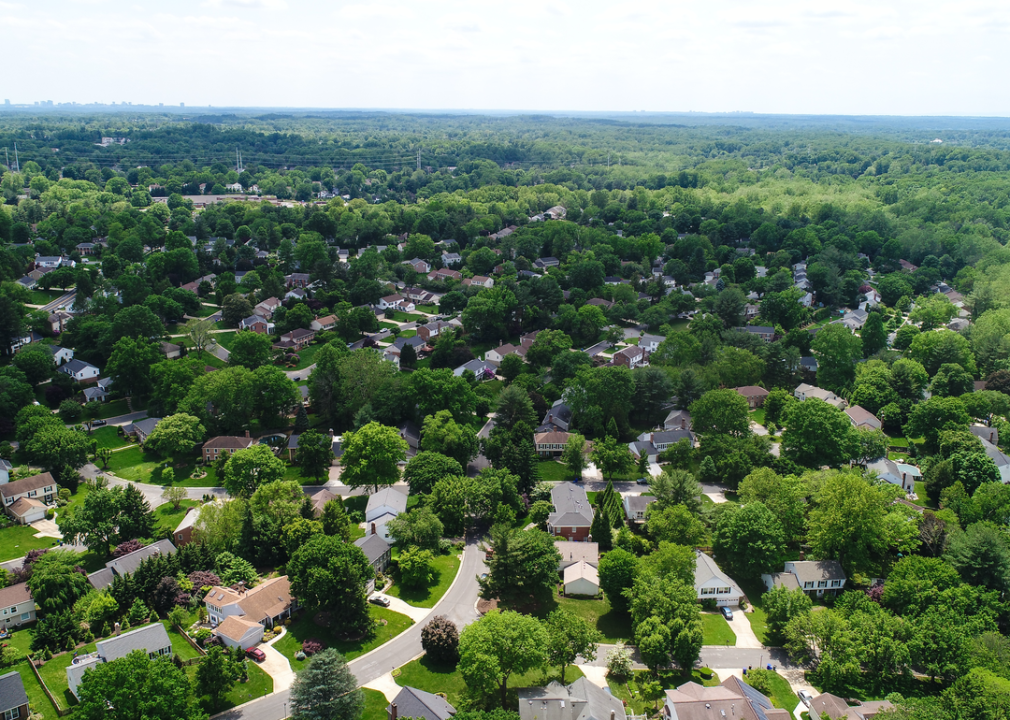
Nicole Glass Photography // Shutterstock
#14. North Potomac, Maryland
– Population: 23,914
– Homeowners: 84% of the population
– Renters: 16% of the population
– Median household income: $171,066
North Potomac is a suburb of Washington D.C., near Gaithersburg and the Potomac River, with good schools and safe streets. It is about 7 square miles and features a North Potomac Citizens Association established to speak for the area. The Nancy H. Dacek North Potomac Community Recreation Center is next to Big Pines Local Park, which features a basketball court, tennis courts, and a place to picnic.

thka // Shutterstock
#13. Brentwood, Missouri
– Population: 8,005
– Homeowners: 64% of the population
– Renters: 36% of the population
– Median household income: $81,069
Brentwood is a suburb of St. Louis. It was on the Manchester Trail and originally called Maddenville after a businessman who owned a grocery store and barbershop. It was incorporated in 1919 and became Brentwood. Brentwood Days is the community’s yearly festival of live music, food, carnival rides, and a parade, culminating in fireworks.
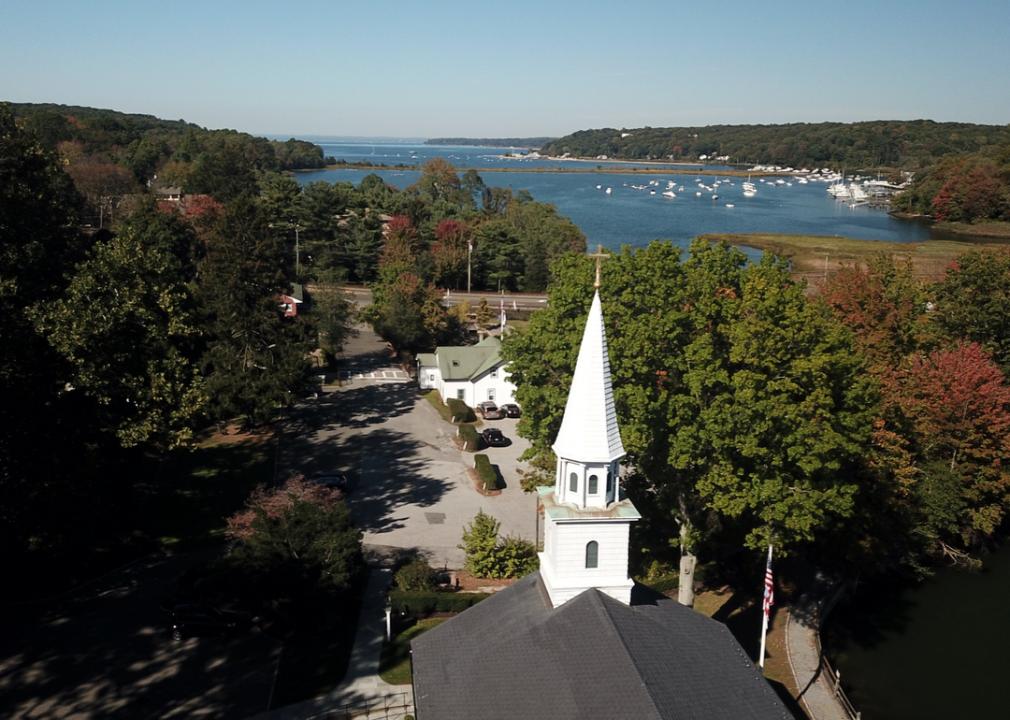
Jose F. Donneys // Shutterstock
#12. Great Neck Plaza, New York
– Population: 6,957
– Homeowners: 59% of the population
– Renters: 41% of the population
– Median household income: $92,260
The village of Great Neck Plaza, incorporated in 1930, is one of nine communities on the Great Neck Peninsula and even early on had an express train to New York City. It is small, only a third of a square mile, but it has a busy downtown, with a train station and more than 250 shops, office buildings, and two hotels. The village has both single-family homes and apartment buildings, and three parks. For seniors, there is a nursing home, an independent living facility, and an assisted-care living facility.
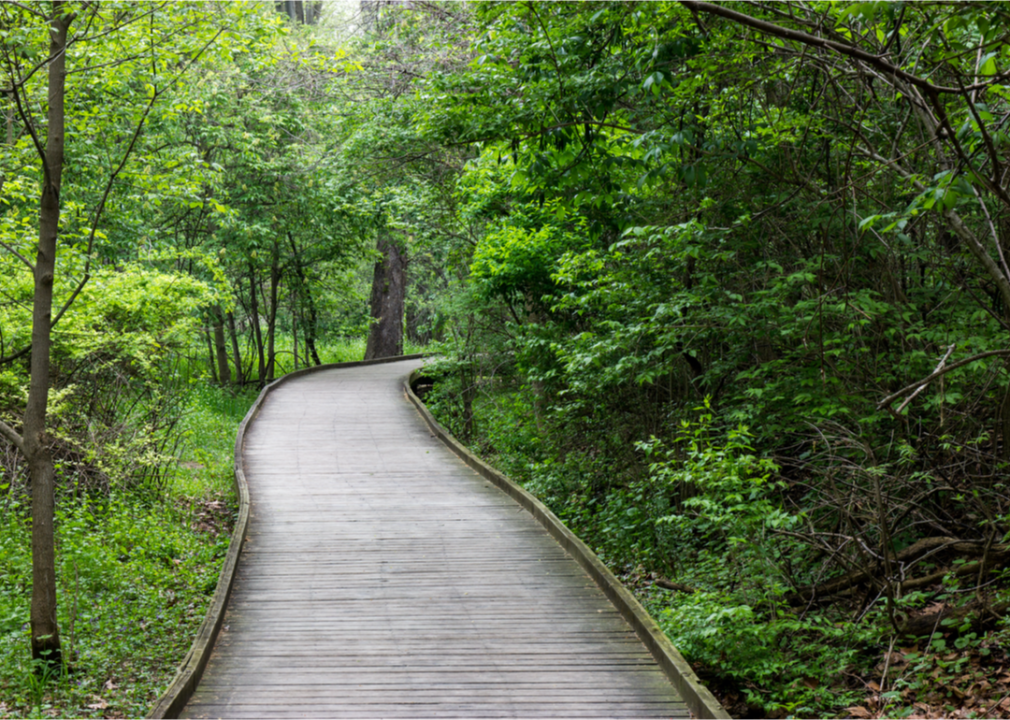
Goff Designs // Shutterstock
#11. Ottawa Hills, Ohio
– Population: 4,450
– Homeowners: 86% of the population
– Renters: 14% of the population
– Median household income: $155,893
Ottawa Hills is a suburb of Toledo that sits on both sides of the Ottawa River. Its development began in 1915 as “a scenic home park,” according to a booklet from the E. H. Close Realty Company. The village offers a variety of classes, provides a Community House for use by residents, and has its own publication, The Village Voice of Ottawa Hills.
You may also like: Best county to raise a family in every state
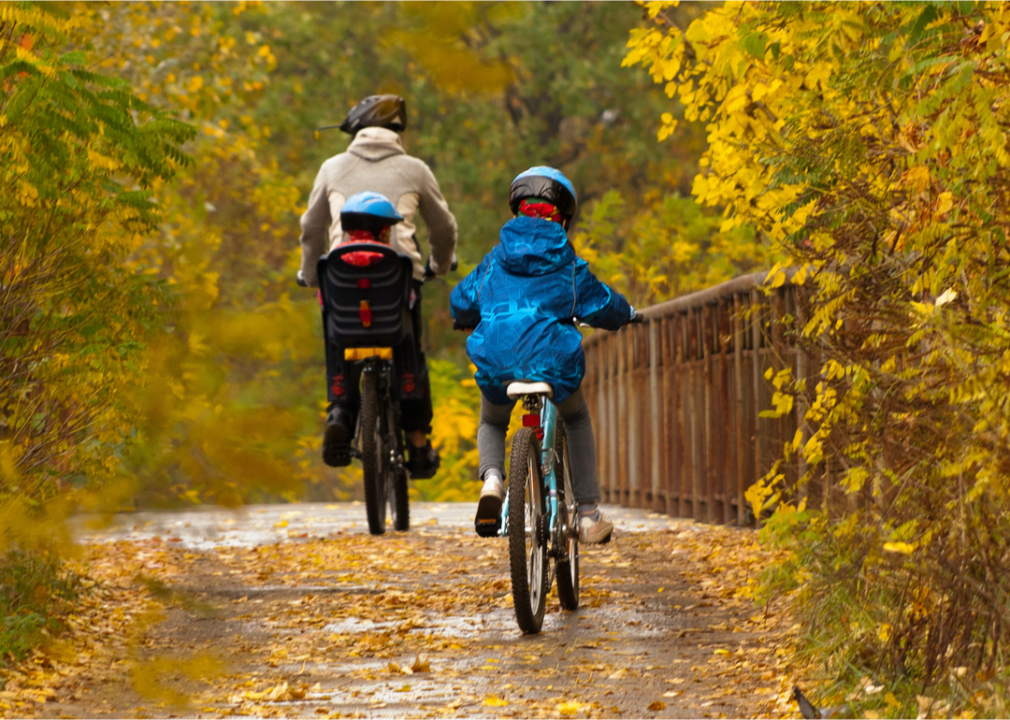
JaySi // Shutterstock
#10. Oakwood, Ohio
– Population: 8,982
– Homeowners: 80% of the population
– Renters: 20% of the population
– Median household income: $112,917
Oakwood prides itself on being a safe and walkable city. Crime rates are low, and children can walk or ride their bikes to one of the top-notch schools, while adults can go to shops, parks, and other destinations. There’s a welcoming, small-town spirit attached to the community’s events, from the MOMs of Oakwood, which sponsors playgroups and other activities, to the new-resident breakfast and the ice cream social that starts the school year.
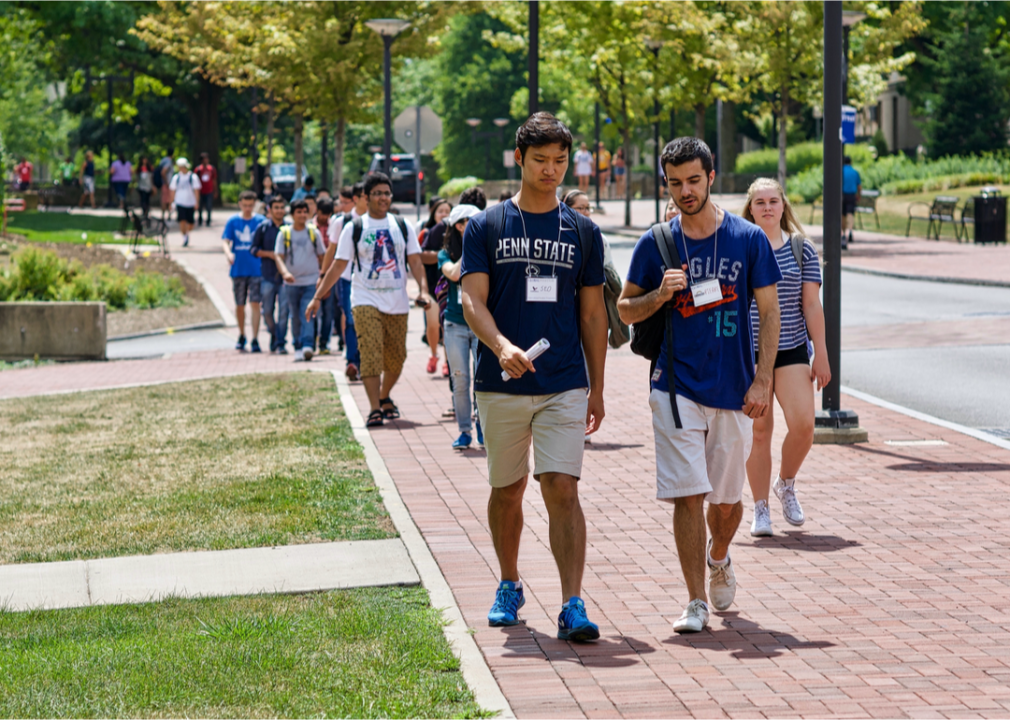
John M. Chase // Shutterstock
#9. Houserville, Pennsylvania
– Population: 1,972
– Homeowners: 82% of the population
– Renters: 18% of the population
– Median household income: $90,750
Houserville is part of the greater State College area. Its schools are excellent, and it offers a community garden. It’s also close to Spring Creek Park, with its covered bridge, 62-acre Millbrook Marsh Nature Center, and the Pennsylvania Military Museum.
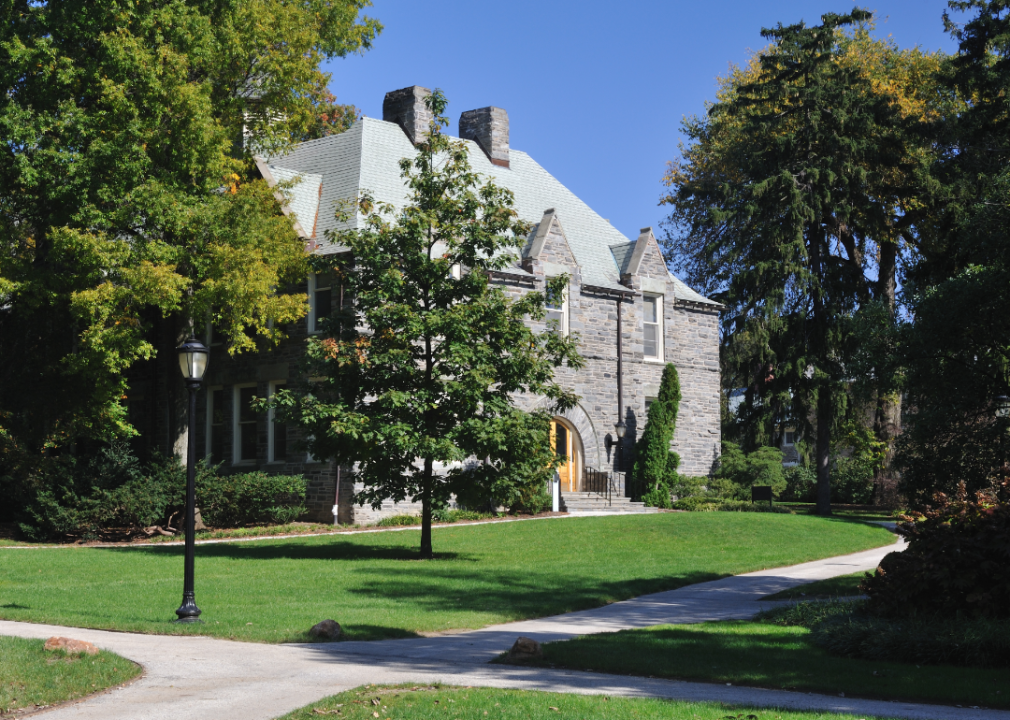
Canva
#8. Ardmore, Pennsylvania
– Population: 12,808
– Homeowners: 59% of the population
– Renters: 41% of the population
– Median household income: $96,780
Ardmore is the largest and most diverse of the suburbs along the Main Line of the Pennsylvania Railroad. When Suburban Square opened in 1928, it was one of the first shopping centers in the country and Strawbridge & Clothier opened its first suburban store in Ardmore. Today, it features a pedestrian-friendly stretch of food, fashion, and the Ardmore Farmers Market. Ardmore’s main street, Lancaster Avenue, offers an array of local shops.
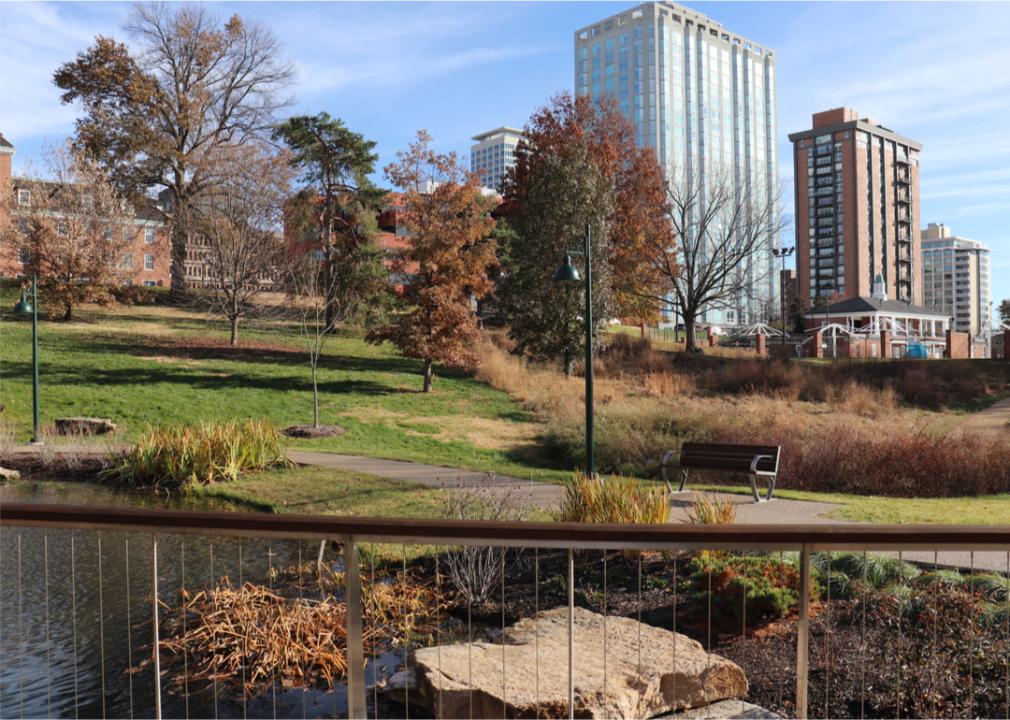
Tales.org // Shutterstock
#7. Clayton, Missouri
– Population: 16,588
– Homeowners: 59% of the population
– Renters: 41% of the population
– Median household income: $107,596
Part of the St. Louis metro area, Clayton was created after St. Louis split off from St. Louis County. The property was donated by two farmers from Virginia, one of whom was named Ralph Clayton. Its new community became the home of a new courthouse and the new county seat. Its central business district is now built up, but some 80% of the community remains residential or parkland.
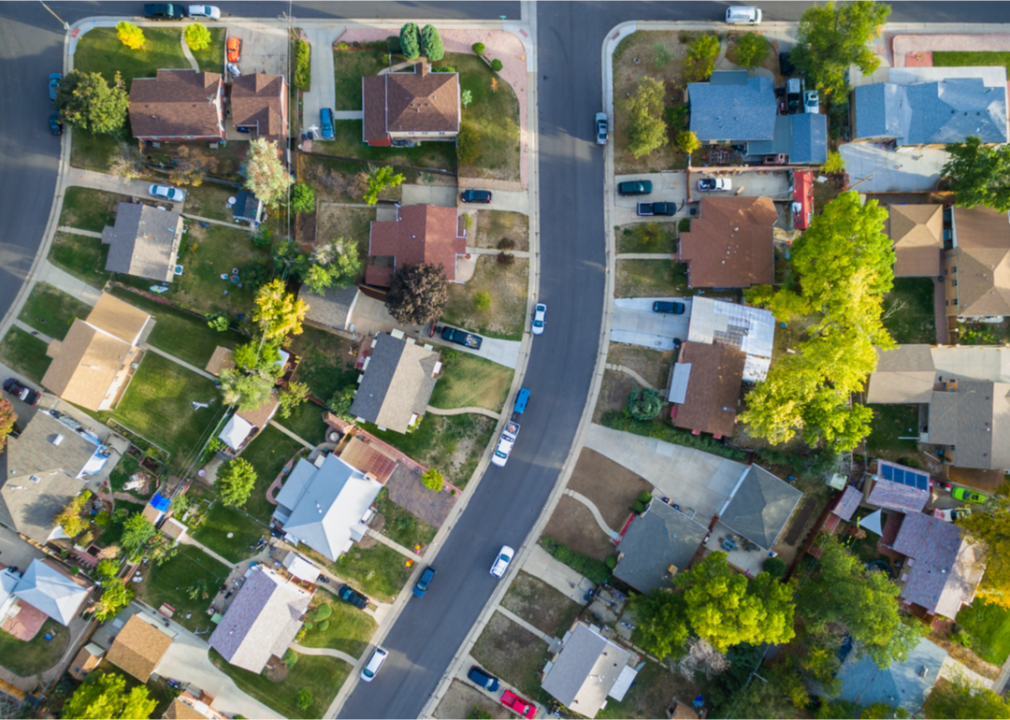
Arina P Habich // Shutterstock
#6. Holly Hills, Colorado
– Population: 2,835
– Homeowners: 97% of the population
– Renters: 3% of the population
– Median household income: $132,955
Holly Hills is about halfway between downtown Denver and the nearby Denver Tech Center. Residents describe it as family-friendly. It’s close to all of Metro Denver and stands out for the availability of housing, low cost of living, the quality of its public schools, and the diversity of its residents.
You may also like: Best places to raise a family in every state
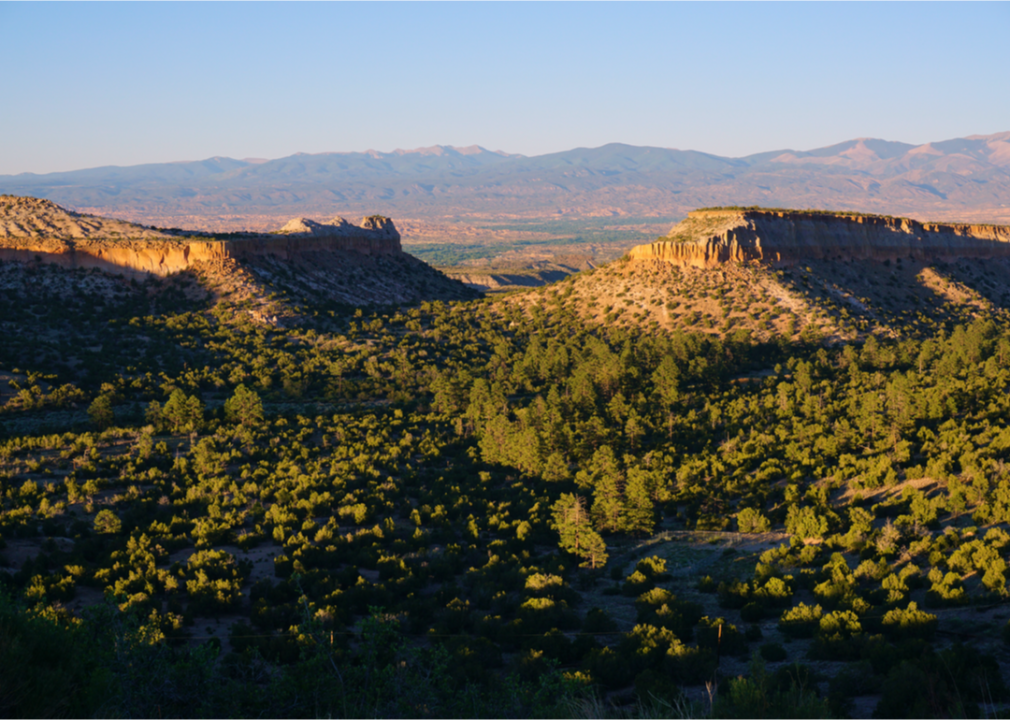
Abigale Snortland // Shutterstock
#5. Los Alamos, New Mexico
– Population: 12,666
– Homeowners: 67% of the population
– Renters: 33% of the population
– Median household income: $116,116
Los Alamos is known for the Los Alamos National Laboratory, where, during World War II, the first atomic bomb was developed, and the laboratory remains a top employer. A 45-minute drive from Santa Fe, it is also the gateway to three national parks: Bandelier National Monument, the Valles Caldera National Preserve, and the Manhattan Project National Historical Park. It was the home of Pueblo people, ancestors of current Native Americans. Its schools are also top-rated.
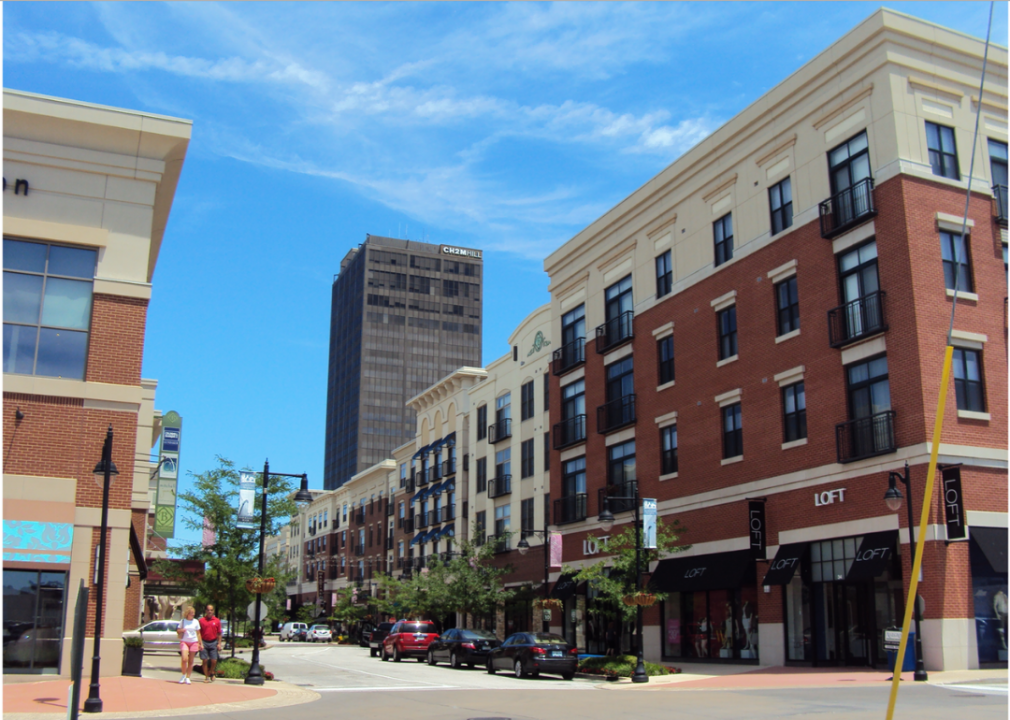
Paul Sableman // Wikimedia Commons
#4. Richmond Heights, Missouri
– Population: 8,500
– Homeowners: 56% of the population
– Renters: 44% of the population
– Median household income: $82,261
Richmond Heights is a suburb of St. Louis. The development, The Boulevard-St. Louis, is an example of the “new urbanism,” combining shops, homes, and office space. The community’s motto is “Progress with tradition.” It has top-ranked schools and a 73,000-square-foot library and community center housing one of the largest municipal fitness centers in the area.
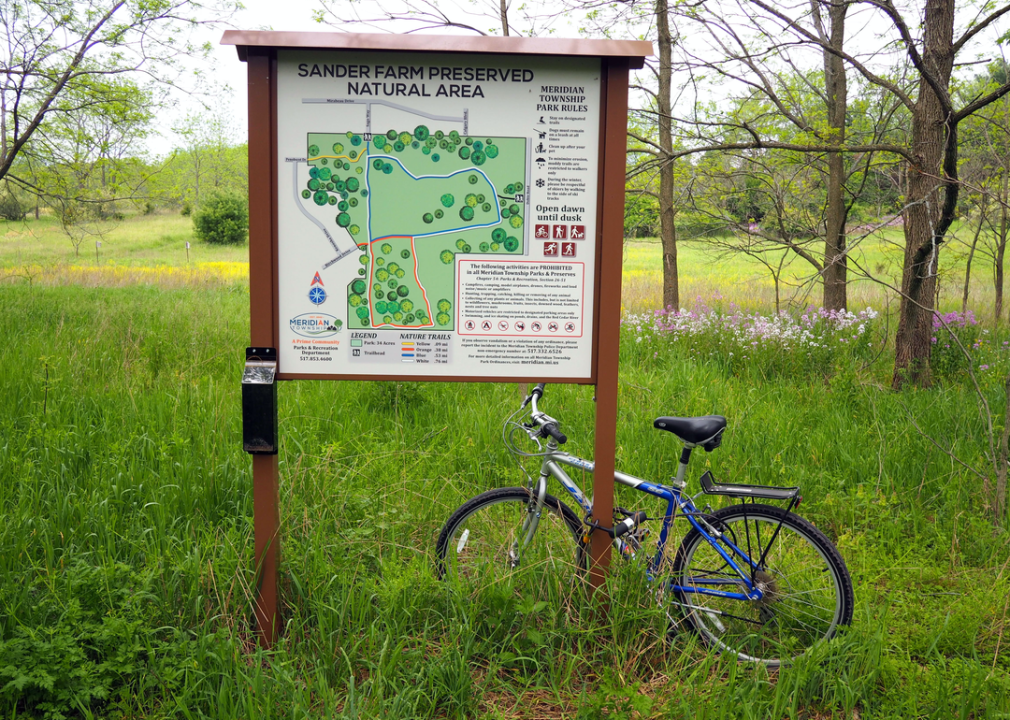
T-I // Shutterstock
#3. Okemos, Michigan
– Population: 24,141
– Homeowners: 61% of the population
– Renters: 39% of the population
– Median household income: $78,600
Okemos is a suburb of Lansing, Michigan’s capital, and near Michigan State University. It was founded in 1839 and was a trading post with the Ojibwa nation. First called Hamilton, it was later named for a chief, John Okemos, of the Saginaw Chippewa. It was originally a farming community.

Osadchaya Olga // Shutterstock
#2. Penn Wynne, Pennsylvania
– Population: 5,932
– Homeowners: 87% of the population
– Renters: 13% of the population
– Median household income: $123,854
Penn Wynne is a part of Lower Merion Township and is primarily residential. The Penn Wynne Park boasts fields for baseball, softball, and soccer, basketball and tennis courts, and a children’s playground. There are coffee shops, top-rated schools, the volunteer Penn Wynne Civic Association, and the renovated Penn Wynne Library.
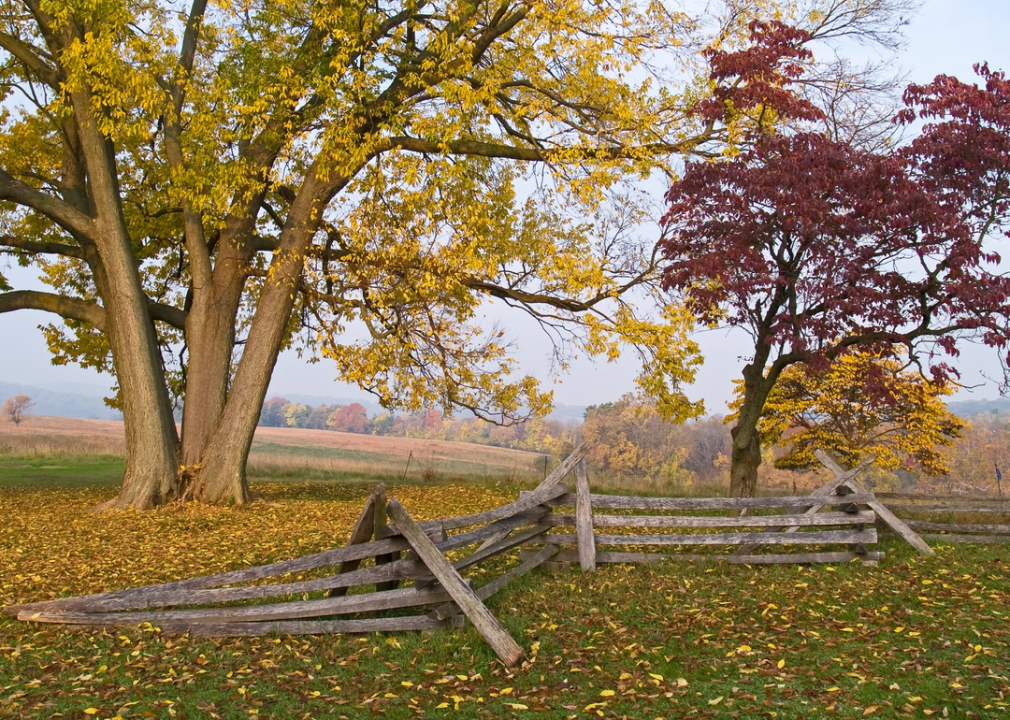
Andrew F. Kazmierski // Shutterstock
#1. Chesterbrook, Pennsylvania
– Population: 4,800
– Homeowners: 77% of the population
– Renters: 23% of the population
– Median household income: $130,000
Chesterbrook is about 20 miles from Philadelphia, near the Valley Forge National Historical Park. Its schools are among the top in Pennsylvania. It is noted for its outdoor activities and nightlife, as well as its diverse community. Chesterbrook has also been repeatedly ranked as one of the best places to live in Pennsylvania.
You may also like: Best places to retire on the West Coast





